The 200 Point Safety Propaganda Conceptual Manifesto: Part 4, by Adam Lehrer
Bullet points 151 through 200 of the 200 Point Safety Propaganda Conceptual Manifesto
151. Andrzej Żuławski Returns Home and Finds His Son Abandoned by His Wife for Several Hours
The Polish film artist and provocateur Żuławski was in a deep depression when he first went to New York to workshop the script that would eventually be turned into his arguable masterpiece Possession (1981). His marriage to Polish actress Malgorzata Braunek, with whom he shared a five-year-old son, was in free fall. Żuławski, exhausted by his travels between Paris and New York, found his wife slipping away from him. This came to a head in 1976 when, after coming home to Paris from the airport, he found his son alone in the apartment. The boy was neglected, covered in jam, and Malgorzata had abandoned him over seven hours previously. Żuławski divorced his wife, and the pain, anguish and rage that the split evoked in him was converted into fuel for his creative practice. Possession is the result of that mania.
In the film, an intelligence asset working for some Western government, played by Sam Neil, learns that his wife, played by Isabelle Adjani, is having an affair. Desperate to repair his marriage, Neil leaves his work and promises his wife to do anything necessary to save their family. It doesn’t work; while he leaves his job to save his family, she leaves her family to indulge in the dark forces of life. Neil is driven to the brink of madness trying to save his son while his wife cavorts with a strange lover, who we learn eventually to be none other than a tentacled Cthulu monster, and it seems like his attempts to snap her out of her lustful fugue are futile. There’s a scene in the film in which Neil returns home to find his son abandoned by his mother and covered in jam in the exact way that Żuławski discovered his own abandoned son. There can be no mistake then: Possession is a film about a male artist’s rage against a woman, and a rage against any woman is a rage against all women. Possession is one of the most powerfully misogynistic works of art ever.
Some feminist art critics, like Agata Pyzik here, have downplayed the misogyny in Possession in attempts to justify its artistry. But the reality is that to downplay the misogyny of the film is to downplay its artistry. Just as Houellebecq located Lovecraft’s racist paranoia as the source of his vibrant imagination, Żuławski’s misogynistic fury is the source of his most brilliant, accessible, and well-crafted film. Safety Propaganda, in principle, is against the suppressing of hatred. Hatred, for all its toxicity, is a vital aspect of the subjective experience. It is a universal state of being. Therefore, we support the exploitation of hatred. We embrace the hate, deconstruct it, and find the central truth that political correctness would have us obscure. Hatred and truth: they sometimes need each other.
152. Ike and Tina: Love and Violence, Beauty and Pain
While I seldom discuss my love of it publicly, the soul and funk music produced at the Motown studios in the 1960s and 1970s is the music that I listen to most often. It is, quite literally, the height of popular music. Stevie Wonder’s “Jesus Children of America”. Aretha Franklin’s Spirit in the Dark. The Temptations Cloud 9. Four Tops’ Reach Out. Bobbie Womack. Curtis Mayfield. Motown or not, the music produced during this era is of a transcendentally universal appeal. It cuts through the human soul. “I tell the world, [it’s] a part of me.”
Despite the vast brilliance of countless records produced by these artists, something about Ike and Tina just hits different, doesn’t it? You know it does. And you know why. No? Well, I’ll tell you why.
Freud believed that anger was but a simple aspect of the fight or flight response. But what happens when anger is combined with love and artistic ambition? Fight? Flight? In Tina Turner’s case, under the dictatorial and violent rule of her lover and genius producer Ike Turner, she soared. It’s a horrifying notion to consider, but one has to consider the possibility that it was the explosive volatility between Ike and Tina that gave their music that extra layer of emotional heft. Tina, on songs like “Poor Fool” and “A Fool In Love”, sounds like she’s excoriating herself for remaining attached to this man. A man who beat her with a shoe stretcher while she was pregnant with their child, who burned her with scalding coffee when he was raging stoned on cocaine, who dragged her to a Tijuana brothel on the night of their marriage. Ike’s violent obsession is audible in the duo’s perfect production; every hook is memorable, every melody soars, and the rhythms are precise and tight. Listening to Ike and Tina is like hearing the fragility of beauty and love. These concepts, however vital to the human experience, can collapse at any moment. They are built on unstable and human foundations. And while I’m glad that Tina got away from that psychotic crackhead Ike, one has to concede that her solo music never quite packed the depth that her music with Ike did.
The Counter-Agent never denies the complexity of the dynamics that define human relationships. To make something truly powerful, and real, we must accept that sometimes it is the darkest aspects of our lives that will yield our most potent cosmic abilities.
153. Andy Kaufman: “Inter-Gender Wrestling Champion of the World”
Kaufman both accurately identified and relished the postmodern moment that he was living in. After having earned stardom for his role in the hit sitcom Taxi, he then took to using the ludicrousness of the ‘70s and ‘80s infotainment sphere to stage elaborate and often deliberately provocative and upsetting hoaxes. He sometimes appeared as a stereotypical immigrant character that was simply referred to as “Foreign Man” and went on shows such as Dick Van Dyke and the Tonight Show. Perhaps most memorably, Foreign Man showed up on Dating Game and audibly cried and complained when the other contestant was selected by the beautiful blonde as her new boyfriend. There was to no end to the lengths Kaufman would go to disrupt the idiocy of mind-numbing American entertainment.
The most epic and long-running bit, however, was when Kaufman entered the WWF as a professional wrestler. Kaufman saw in WWF a kind of performance art, as evinced by the nature of its kayfabe staging, that could appeal to the masses. Kaufman developed his own concept of for the “Inter-Gender Wrestling Champion of the World,” in which the comic would offer $1000 to any woman who could actually pin him. Kaufman was despised and beloved by the audience in equal measure when he’d taunt the women and laugh at their inability to take him on physically. He employed the talents of artists like Debbie Harry and Laurie Anderson to play along as he’d thrash them about on stage, delighting in pantomimed violence against women. His act has become newly relevant once more, given the acceptance that transgender women with infinite more biological strength than cisgender women have earned in competing against trans women in violent contact sports, but that’s neither here nor there.
Later, after being initially rebuked by Vince McMahon in his attempts to join the WWF, Kaufman befriended professional wrestler Jerry Lawler and the two devised what would become an utterly surreal public feud. For years, Kaufman would hurl verbal abuse at Lawler only for Lawler to severely “injure” his “nemesis.” In some of the matches, Kaufman would bring out the league’s various heels to act as human shields in between him and Lawler’s wrath, and Lawler would inevitably beat the shit out of the heel and then maim Kaufman’s body in some way or another. They once took their act to Letterman’s show, after Kaufman was piledrived in a match with Lawler, in which Kaufman appeared with a neck brace and demanded an apology from Lawler. Letterman played along and showed several videos in which Kaufman ridiculed Lawler for his comparative lack of stardom: “I’m a Hollywood star, OK? You will never be a star you ignorant hick.” Kaufman’s whining intensifies until Jerry finally gets up and smacks Kaufman across the face. The line between performance and reality blurs ever further, and even those that thought they were in on the joke were confused by the dynamics between the two performers.
Kaufman was one of the truest Counter-Agency stars to emerge in the last quarter of the 20th Century. His artistic ambition and zest for information warfare were limitless, and he shunned all conventional forms of artistic media for what he accurately identified as the most powerful of all propaganda tools: the media itself. Kaufman created bits that reverberated throughout the entire world, leaving a morass of confusion and anger in his wake. He was a vessel for information in postmodernism: slippery in meaning and impossible to project cohesive narrative onto.
154. Butoh is Born, Hijakita is Banned
When Tatsumi Hijakita and Kazuo Ohno first conceptualized the abject and provocative Japanese dance style that was to be known as “Butoh,” they were doing so in response to very specific historical circumstances. First, they were rejecting the imperialism of Western cultural infiltration of Japan following the end of World War II – that is, refusing to perform in the styles of ballet and other forms of European dance that were becoming popular as Japan became westernized. Second, they were also trying to move away from the trappings of Japanese Noh, which was becoming stereotypical and inviting of the fetishistic eyes of Western viewers. The artists wanted to develop a style of dance that interpreted the belabored and anguished movements of Japanese common folks. To do this, they derived inspiration from Japanese authors like Mishima. More intriguingly, however, was the amount of influence they grasped from Western surrealist artists who, nevertheless, deified and celebrated the forgotten outsiders of the peripheries of a society: Artaud, Genet, Lautréamont, and Sade among them. Just as Genet presented the criminals and degenerates of France as his heroes, butoh would make hero figures of abject outsiders using jarring bodily movements, sickening makeup choices, and an otherworldly aura in which humans transmogrify into animals and embody pain and distress.
The first Butoh performance was a Hijakita piece performed in 1959 at an unsuspecting dance festival. Kinjiki, or “Forbidden Colors”, was inspired by the faggot-obsessed content of Mishima. Hijakita, through motion and provocative gestural work, explored the taboo of homosexuality to a shocked and enraptured audience. The piece ended with Ohno’s son, then still quite young, holding a live chicken between his legs alluding to some sexual act until Hijakita chased the child off stage. The festival, outraged by what they had just allowed to be shown, banned Hijakita from the festival indefinitely. This first brush-up with censorship solidified Hijakita as an iconoclastic freak of the dance world and Butoh as one of the most thrillingly unique art movements to emerge from the mid-20th Century. This is what all Counter-Agents should aspire to. To create something so shockingly new that no one can even accept it as art until years after you first unleash it upon the world. The mind virus moves slowly, infecting one host before moving onto another, but by the end the entire world and those who inhabit will be irreparably altered.
155. Stanley Kubrick and the Staging of the Moon Landing and The Shining Confession
As soon as the NASA Apollo program launched cameras into space and brought back photographs of both space and the moon, conspiracy theorists rejected all the imagery as fakes. After all, America was both well behind Russia in terms of rocketry, but lightyears ahead of Russia in terms of filmmaking. These conspiracies intensified when Neil Armstrong and Buzz Aldrin actually walked the surface of the moon during the Apollo 11 mission. For many, the idea that we could actually send men into space to take a waltz through our orbiting rock was just too phantasmagoric to be real. “Yeah fucking right,” we said, “This isn’t a fucking sci-fi movie.” America has never shied away from an elaborate propaganda campaign when it came to the Cold War, and what could be sweeter than beating Russia to the moon while making good on JFK’s ill-begotten promise to do such a thing. But maybe it really was a sci-fi movie. Maybe the conspiracies are correct.
If anyone had the monstrous talent that would be required to manufacture a moon landing spectacle, it was Stanley Kubrick. The auteur had just bedazzled global audiences with his space opera, 2001, in the previous year of 1968. This conspiracy intensified when The Shining was released less than a decade after the “moon landing.” The horror masterpiece inspired its own legions of conspiracy theorists obsessing over its every detail — a cultural mania examined in the documentary Room 237 — who found what they thought to be encrypted admission by the filmmaker that he indeed did stage the moon landing on behalf of the American imperial empire. The changes made to Kubrick’s script from King’s novel are notable. The room in the novel that appears to be the source of the Overlook Hotel’s macabre power, Room 217, is Room 237 in the film. The moon is 237,000 miles from the Earth. Nicholson’s job in the film is as The Caretaker of the Overlook Hotel, a once grand structure fallen to decay that maintains itself through illusion and spectacle: “Later, the hotel is engulfed in a winter storm—that’s the Cold War which drove JFK to make that silly promise about putting a man on the moon.” Kubrick’s portrayal of Jack Torrance is profoundly pessimistic, because he was of course deeply pessimistic about the role he played in propagating the fictions of the United States.
You’re god damned fucking right I believe that Kubrick staged the moon landing. The American government has already lied about seemingly everything, so why not this? That said, I don’t understand why Kubrick would feel guilty about his role in the fantasia. Is this not the goal of the Counter-Agent? To create a ruse so elaborate and layered for little reason more than the sheer excitement of mass deception? We need guilt though. As artists, we need to have a complicated attitude towards everything that we do. His guilt about the fake moon landing propelled Kubrick to make The Shining. Where will your guilt take you? What will it inspire in you?
156. The Caretaker and the Haunted Ballroom
The Shining, a perpetual touchstone in the Safety Propaganda lexicon, drones out further in the early music produced by Leyland Kirby at the onset of his project beneath the name of The Caretaker. The Caretaker, of course, is yet another reference to Jack Torrance of The Shining. And on his first record as The Caretaker, Kirby sampled recordings from 1920s and ‘30s ballroom pop and transmogrified them through an assortment of electronic effects to convert them into the kind of music heard in the score of The Shining – the music sounds, quite literally, like the hazy, fluid, and polymorphous memories of someone who had never even experienced the memory in the present tense. They are memories as a subjective construction of the subconscious mind. They are the memories of something that we have thought about but never actually seen first hand. The sound creates a most potent abstract art that alludes to a feeling of nostalgia for something that never came (yeah yeah hauntology yadda yadda fuck it whatever).
Safety Propaganda adheres to a doctrine of memory as a fluid entity; something that can be distorted and manipulated to our own ends. The schizoid landscape of late modernity is already one without fixed meaning or identity. With that weakness in mind, we can rewrite it with our own ethos and our own intentionality.
157. The Self-Mutilation of Van Gogh
Van Gogh is the genesis of the tortured artist trope. It is due to the contradiction between the extreme, sensuous beauty of Van Gogh’s paintings and the abject and despairing life that the artist lived that we have a cultural concept of what it means to be burdened by creative genius. This life, as thrilling as it can be, is lonely. To see the world for what it is — to know exactly what it is that you refuse to reckon with — is as much a gift as it is a curse. Van Gogh is the prototype of our disaffection.
Van Gogh’s madness was exacerbated while living with and painting alongside Gauguin in Aries, where Van Gogh had hoped to build an artist colony. His art dealing brother Theo represented Gauguin and introduced the two painters, who hit it off. At first, their time spent working together in Aries was highly productive, and indeed Vincent produced some of his most historically valuable works during their cohabitation – not that he would ever see the riches produced by those works before his own death, mind you.
Alas, the relations between two notable Counter-Agents can and will be unsteady, and the relations predictably fractured between Gauguin and Van Gogh rather early into their time living together. Gauguin, a rather steady and confident man, found Van Gogh’s misery and mood swings to be performative and self-aggrandizing. Van Gogh, however, found much to complain about in Gauguin’s slow turn away from the impressionist style that they together had helped pioneer. Eventually, Gauguin was ready to leave. Van Gogh felt the tension and finally asked Gauguin if he planned on leaving. When Gauguin said that he was indeed planning to leave, Van Gogh broke out into hysterics. Gauguin gathered his belongings and left the house. While walking down the road, he heard the steps of a man following him. When he turned around, he glimpsed a Van Gogh with an expression of demonic rage (or perhaps possession?) smeared across his face holding a razor in his hand. Gauguin must have just given his friend a look of somber empathy, because Van Gogh relented. Despaired, Van Gogh turned away and walked back to the house.
While the details of what came later are scant, we do know that after Gauguin went off to a hotel that Van Gogh made his way home. He woke up in the hospital with his own ear chopped off, seeming to have sliced it off after waking up during the fit of madness. The Counter-Agent, you see, always makes his point known. Whatever he is trying to say will be said, regardless of the personal cost.
158. Bataille’s Fascination with Gilles des Rais
Gilles Des Rais was simply a brutal man of war, a powerful nobleman without discretion, without scruples. He owes his lasting glory to his crimes. – Bataille
Gilles des Rais began his military career as a lieutenant to the martyr Joan of Arc. After her execution, he fled to his estate in the French countryside. While home, he indulged his perverse fascinations and took up an unprecedented hobby: he started slaughtering hundreds of children, winding up the first convicted serial killer in recorded European history.
It is not at all shocking that Bataille, the “philosopher of excrement” according to Breton, would be drawn to such a shockingly contradictory figure of history. For it is Bataille, after all, who said that the essence of poetry itself was located within its “violent contradictions.” What can be more contradictory than a holy man who fought and would have died for one of the most noble saints of martyrdom, only for that same man to go home, murder children in bizarre Satanic rituals, sodomize and violate their defiled corpses in unspeakable ways, and keep the heads of the “beautiful ones” as tokens of his malevolent deeds? Not many things, I’d wager.
The essence of poetry is in these contradictions, and the essence of poetry is truth. A noble, heightened, and transcendental truth. A truth occulted from normal discourse only to be unraveled through radical actions. Murder, of course, is a despicable action. But as truth mongers, Safety Propaganda vows to never avert its proverbial eyes from such jarring intellectually clashing ideas. We will look, by god, to report the truth embedded in the morass of juxtapositions.
159. Alexander McQueen AW1995: Highland Rape
Oh, to be a Counter-Agency certified artistic genius trapped within an industry that, no matter how hard you push it and evolve it forward, would never truly amount to more than mere commerce – it’s a tragedy, no doubt. The untimely loss of Alexander McQueen, hanged by a noose on a cocktail of booze, blow and sleeping pills, in 2010 robbed us of what was, perhaps, the greatest mass media artist to arise in the ‘90s and ‘00s. A McQueen show was more than a catwalk, indeed. It was a spectacle, you see, that collapsed the distance between postmodern commerce and the modernist avant-garde. Every collection wielded a most potent thematic contradiction that would be written off by screeching bourgeois feminist fashion writers as misogynist but actually made insightful critiques of the fashion industry’s own ghoulish market sensibilities. His Spring-Summer 1997 show La Poupeé, for instance, referenced Hans Bellmer’s fetish doll sculptures (McQueen was passionate about grotesque, abject, and upsetting works of modern art); some critics were enraged that he would interpret living models in the vein of Bellmer’s statuesque objects of lust, but this only intensified McQueen’s criticisms. Fashion is an industry of fetish, and imagining a model as a fetish doll is only a hyperbolic rendering of what a model is in actuality.
McQueen’s status as an enfant terrible of high fashion was solidified during his Autumn-Winter 1995 exhibition. Entitled Highland Rape, the show depicted models in violently torn clothing staggering down the runway, as if just having survived an assault or a rape. Polarizing audiences, McQueen was simultaneously hailed a rising genius of the industry AND a self-involved and misogynistic edgelord who lacked empathy towards his subject matter. And yet, the lingering discourse evoked by the show is itself that polarization. For McQueen, the catwalk wasn’t just a display of recently grafted high-quality garments – it was the ultimate expression of the artist’s subjectivity. For the fashion designer, the catwalk is the full-length LP or the feature film or the solo exhibition. McQueen exploited fashion’s considerable limitations to reimagine it as a most potently spectacular anti-art. How, one asks, could clothing invite such a jarring response? Because McQueen was an artist, a Counter-Agent, embedded within it. McQueen’s early shows led to a total reimagining of the catwalk in the industry. Rick Owens, Raf Simons, and to a lesser extent Miuccia Prada all followed in his wake. The fashion show was now an art form, or at least to be looked at as such.
Nevertheless, McQueen never could fully accept the contradictions of his own industry. No matter how grand his aesthetic gestures would become, he knew he would be tethered to commerce. Perhaps it’s what killed him.
160. Marquis de Sade: A Man of his Word
I almost felt compelled to leave Sade absent from this manifesto for one main reason: the history of literary transgression is almost entirely post-Sade. Even when not explicitly acknowledged, Sade is the phantom that haunts this legacy in perpetuity. I wouldn’t be here, on this blog, scribbling away if he had not done so from the comfort of his French asylum. Nor would Dennis Cooper. Nor would Burroughs. Nor would Artaud. Nor would Bataille. Nor would Huysmans. And so forth. Alas, I digress…
He must be acknowledged. A founding member of the Counter-Agency of the Avant-Garde, Sade’s work is enduringly excellent for its pitch black humorous depictions of sadism, for its imminently legible style, and for both indulging in and remaining critical towards the culture of self-gratification that was rising to the fore following the bourgeois revolutions.
A true Counter-Agent can’t just be an analytic outsider, observant and distant; he must, at some point and to one degree or another, partake in his obsessions. Sade’s life is particularly relevant to study because his staunch atheism is arguably what validated his world view. God, as Nietzsche declared in nearby Germany at around the same moment, was dead. If the world is godless, then surely Sade should have no compunction about his liaisons with prostitutes and the men and women peasants that he brought into his estate to fuck and write about and fantasize about and fuck some more. In Sade my Neighbor, philosopher and artist Pierre Klossowski posited that Sade’s life and art were precursors to the burgeoning nihilism of early industrial modernism, and that Sade inhabited a kind of “villain philosopher”:
“If the summit of villainy consists in disguising one’s passion as thought,” writes Klossowski, “The villain for his part in the thought of decent man nothing but the disguise of an impotent passion.”
When Napoleon imprisoned Sade, it wasn’t for Sade’s libidinal passions. As always, it was for the novels Justine and Juliette in which Sade told the world about his libidinal passions. The implication here is clear as day: Sade’s lust for sadism was hardly rare amongst the French aristocrats of the 19th Century, and his compatriots couldn’t have the bad PR. Thus, Safety Propaganda fears not of being positioned as the villain philosophers. Villainy is too subjective. Those that claim heroism are fucking liars.
161. Giordano Bruno and his Heresy
Safety Propaganda is a state of constant negation. A virulent heretical scream. Giordano Bruno was the apex heretic.
A 16th Century Italian Dominican Catholic friar, a mathematician, a poet, a cosmological theorist, and a hermetic occultist, Bruno’s thirst for secret knowledge was limitless and the man refused to limit himself to the arbitrary boundaries set by the Vatican. Bruno believed in God, and also trusted that there was a point to the structured dogmatism of Catholicism, but insisted that he could believe in the Church doctrines while still exploring ideas that negated it. Bruno’s most radical and enduring concept was his belief in the the infinite nature of the universe. He believed, in contrary to Catholicism which dictated that God created this and only this world and universe, that there were infinite universes and infinite worlds. Bruno’s "the coincidence of contraries" (coincidentia oppositorum) — which basically dictates that everything in the universe generates its opposite, against which the thing becomes self-sentient — plays an important role in Joyce’s Finnegan’s Wake. Joyce referred to Bruno’s trial in the text on numerous occasions, and even uses the theory as a way of creating pun and rhetorical deconstructions that further fragment the reader into a universe of ambiguous thought.
Bruno’s stances earned him the rage of the Vatican. In 1600, he was captured, tried, tortured, and burned at the stake. Because Bruno believed in the infinite nature of the universe, however, he reportedly expressed almost no fear in the face of his violent end. After being sentenced, he replied: “Perhaps you pronounce this sentence against me with greater fear than I receive it.” A true freedom of mind is also a freedom from fear. Death isn’t the end. The end doesn’t exist.
162. Warhol’s Alienation from Mainstream American Life
Not everyone thinks that Andy Warhol was a great artist — those who think that he wasn’t are morons, of course, but that was neither here nor there — but no one can deny the seismic influence that he had on American pop culture. As the pop artist with most universal recognition, Warhol’s practice seamlessly blended his fixations on American consumerism, celebrity culture and glamor with theories and disciplines that couldn’t be described as anything other than avant-garde. The circulation of his paintings of soup cans and portraits of Marilyn Monroe doesn’t diminish at all the supreme fucking weirdness of his films nor the transgressive allure of those who orbited The Factory and what Warhol’s studio represented conceptually.
Was Warhol acting with such an end goal in mind? Well – yes and no. I think something interesting to examine when it comes to Warhol is the depictions of the artist in feature films. Warhol has been portrayed by countless actors with wildly varying success at this point: by Bowie in Schnabel’s Basquiat biopic (the decent), by Jared Harris in Mary Harron’s I Shot Andy Warhol Valerie Solanas biopic (the good), by Sean Gregory Sullivan in the asinine 54 film (the bad), by Crispin Glover in Oliver Stone’s disastrous The Doors Jim Morrisson biopic (the ugly) and more. The unifying failure in nearly all of these performances is a tendency to inflate Warhol’s eccentricities. He seems like a total freak. Actual footage of Warhol reveals a much more layered man. He was almost down-to-earth. Playful. He had a great sense of humor and a subversive wit. He was, despite his flagrant faggotry, quite a normal and likable guy.
And yet all anyone saw for a long time was the freakish aspect of who he was. The artist and iconoclast. But Warhol desperately wanted to be accepted by mainstream American culture. He often fell in love with men for their ability to pass as straight. He started Interview Magazine primarily for the purpose of getting invited to film premieres, which he’d previously been incapable of doing despite his pedigree as one of the most important underground filmmakers in America. He wasn’t critiquing consumerism so much as he was expressing his undying love of what America represented. But Andy knew that he would never truly be accepted by the American mainstream unless the mainstream, somehow, got gayer. Weirder.
Can anyone possibly deny that Warhol’s impact isn’t everywhere? Mainstream media figures discuss transgenderism on a nightly basis. Our most famous pop stars — Lady Gaga or Katy Perry or Rihanna — all utilize a Warholian blend of high and low culture and the touchstones of drag and gay culture. Nearly all of our culture is post-Warhol. Warhol, even if he was denied it in his lifetime, has become the establishment.
The most effective Counter-Agents can often have very narrow and self-serving goals, like acceptance, but nevertheless pursue those goals so ruthlessly that nearly all of society and culture is altered beneath the force of their psyops, for better or worse.
163. Les Rallizes Dénudés and Japan Airlines 351
The Japanese psychedelic/avant rock band Les Rallizes Dénudés formed in the late 1960s. Their music is almost shockingly bewildering given the time period that the band formed. At times sounding like The Velvets at their most caco phonic “Sister Ray” white noise delirium and at other times sounding like Hendrix performing an ancient rite on a sigil platform, they were a glorious monster of a band. They are also mysterious. We know very little about the band’s members. Despite or maybe even due to their enigmatic nature, they are fucking legends of weird rock n’ roll that demand a unique and obsessive fandom. They never produced a proper album, meaning engagement with their recorded output is limited to bootlegs and live recordings. Like The Velvets, they manage to play their classics songs like “Night of the Assasins” in a near endless variety of ways in a live setting. The same song can be a slowly drifting, hypnotic nod out in one performance, and then as a shockingly loud noise freakout in another. Unlike The Velvets, they don’t have four masterpiece LPs to return to. This too is part of LRD’s appeal.
What we do know about the band only amplifies the mystique around Les Rallizes Dénudés further. The members, including their enigmatic leader Takashi Mizutani (who died in 2019, but whose death was kept a secret until last year), were members of the Japanese Red Army. The Red Army was a militant communist group dedicated to both overthrowing the Japanese empire and to joining and leading a global proletarian revolution. In 1970, LRD’s original bass player Moriaki Wakabayashi was one of the Red Army members involved in the hijacking of Japan Airlines Flight 351. The airplane, which was intended as a domestic flight, was taken by several members of the group. They demanded that the plane fly to Cuba, where they were to be trained by Castro’s forces as guerrilla warriors. They were disappointed to learn that the plane couldn’t actually fly that far, and eventually negotiated it to fly to North Korea where they were taken in as refugees.
The Japanese Red Army was ultimately a futile and youthful misadventure, as most militant organizations were. But what it lacked in political potency, it somewhat made up for in its adding to the aesthetic mystique of LRD. Once again, we return to myth building. To make an impact, you must generate a mystique.
164. A Piece of Robert Bloch Dies with Lovecraft, Bloch Lives
In all his stories, there is only one writer that Lovecraft dedicates a piece of writing to. In “The Hunter of the Dark” from 1935, Robert Bloch appears thinly disguised as the protagonist Robert Blake. Bloch dies within the text, allowing Lovecraft to respond to a story by the younger writer in which the Lovecraft-inspired protagonist dies.
At the beginning of Bloch’s career, encouraged by Lovecraft’s professional recommendation and guidance, he submitted stories to Weird Tales that operated within the Cthulu mythos. When Lovecraft, the poet of racial paranoia, died in 1937, Bloch was devastated. He was devastated personally, but also by the realization that the loss of Lovevcraft was barely felt at all. His legacy was nonexistent upon his death, and no one loved him. Aside from Bloch, that is. Bloch said that a piece of his soul died with Lovecraft. But which part?
Perhaps the part of him that died was the part that was better off dead. With Lovecraft gone, Bloch felt no burning need to impress his mentor nor to create stories that flattered Lovecraft’s universe. He was, in a way, free. And his work changed, and became iconic in its own right.
Bloch turned away from the Cthulu and towards the horror of the material world. A lingering interest in the outside forces that shape reality would remain — he did a series of stories about Jack the Ripper in which the Ripper needed to murder whores to maintain his immortality — but by juxtaposing the Cthulu sensibility with true crime he was able to examine the ways in which evil manifests as a cosmic force upon perceivable reality. His most iconic novel is, of course, Psycho. While Ed Gein was arrested two years before Bloch unleashed Norman Bates upon the world, Bloch was living within 20 miles of Gein without ever knowing about Gein’s crimes. That Norman’s murderous habits in the novel are so close to Gein’s without Bloch’s knowledge of the details is only further testament to the ways that some Counter-Agents can feel the presence of malevolent energies on a subconscious level. We just know when something is off – when strangeness is afoot. A sixth sense. A 7th and an 8th sense.
In losing Lovecraft, Bloch was able to take the lessons of his handler without being bound to his handler’s whims. He came into his own. We all must know when to sever ties. Learn what you can, and let the old die and the past fade away. Seize your own destiny. Make the world bend its knee to your righteous fucking glory.
165. Lawrence Pazder and the Satanic Panic
I’m a writer and an artist. I’ve written a lot of words and made some art. I feel proud of what I’ve done, and yet I’m not even close to fulfilled. I won’t stop until I’ve created a panic. Most artists attempt their whole lives to achieve what Lawrence Pazder did with a little pseudo-science, some literary license, and a leap of faith. The greatest art generates hysteria. Pazder then is possibly our greatest artist.
Pazder created a book around a series of recovered-memory therapies, a practice now almost unanimously discredited, with his patient and soon-to-be wife Michelle Smith. By exploring the “memories,” they learned that Michelle had been ritualistically abused by a “Church of Satan” (Anton LaVey sued for libel, and Pazder had to admit that it wasn’t actually THE Church of Satan, meaning he likely didn’t know that there was already an organization with that name the cheeky bugger) at a graveyard over the course of 80 days when she was five-years-old. The book is almost absurdly implausible, and an absolute thrill to read. The triggering nature of the content against the backlash of the sexual revolution met head on, and in Pazder’s wake – the Satanic Panic ensued.
Americans came to believe in large numbers that Satanic pedophile rapists were running institutions as powerful as Hollywood down to ones as weak as your local school board. Sex. Rape. Violence. Satan. Oh baby, just lose yourself in the rhetorical delirium! There are Satanists everywhere! PREYING ON YOUR CHILDREN! It feels good, doesn’t it? Just throw your rational mind out the window and mainline the hysteria right into your pulsating cock vein. Prick. Aspirate. Damn that feels good!
Fiction? Reality? What’s the difference? Pazder likely understood that the differences between the two had grown increasingly meaningless at the onset of the 1980s. He seized the moment. We salute him.
166. E.E. Cummings Travels to the Soviet Union
Despite the surreal strangeness of his prose and his associations with communist ideologues like Louis Aragon, poet and artist E.E. Cummings hated leftists with every fiber of his being, voted Republican, and maybe somewhat dismayingly was an ardent supporter of Joseph McCarthy.
He wasn’t always such a hard-liner. Early in his career, he would just politely decline political discussions. He traveled to the Soviet Union in the ‘30s. He didn’t go for any other reason other than to travel around some. He infamously published his customs interview transcript and it reads as evidence of his nonplussed and humorous apathy.
Why do you wish to go to Russia?
because I’ve never been there.
(He slumps,recovers). You are interested in economic and sociological problems?
no.
Perhaps you are aware that there has been a change of government in recent years?
yes(I say without being able to suppress a smile).
And your sympathies are not with socialism?
may I be perfectly frank?
Please!
I know almost nothing about these important matters and care even less.
(His eyes appreciate my answer). For what do you care?
my work.
Which is writing?
and painting.
What kind of writing?
chiefly verse; some prose.
Then you wish to go to Russia as a writer and painter? Is that it?
no; I wish to go as myself.
Nevertheless, Cummings’ stay in Stalin’s Soviet Union would shape him immeasurably. He understood rather quickly that Western communists were delusional to think that the Soviet system was a preferable rectification of the contradictions of capitalism. Moreover, he was fiercely committed to his artistry, and simply couldn’t abide the fact that Soviet artists were forced to sublimate their subjectivity into a state project. Cummings created art for himself and himself only. Ruthless dedication to the self, an autocratic insistence on one’s own glory, is a good rule of thumb for the Counter-Agent. We are our own cause – or, perhaps, a loosely networked of interconnected causes combining towards an ambiguous but ever-present end. If you find yourself sacrificing the vision of the self in service to a cause that you aren’t sure that you even believe in, you’re losing.
167. The Pre-Pubescent Seduction of Austin Osman Spare by Mrs. Patterson
Occultist, writer and artist Spare attended a school attached to the Anglican Church as a boy at the end of the 19th Century. While there, he says that he fell under the tutelage of an elder woman that he called, simply, “Mrs. Patterson” or “Witch Patterson.” According to Spare’s own documentation, the older woman seduced the young Spare. She took his virginity, showed him the experiences of the flesh, and taught him magic. Given the system of magic that Spare developed and its insistence on the metaphysical power of human sexuality, it would make perfect sense that his early experiences with the occult were attached to pleasurable but scandalizing sexual experiences. One can imagine Spare in awe of this older woman, terrified of her, but losing himself in her thrall and giving himself over to the macabre forces normally suppressed by mankind. Spare used his libido to see that which we either cannot or will not.
Of course, Spare’s biographer noted that the likeliness that Mrs. Patterson existed at all is incredibly slim. But this doesn’t negate my point. It reinforces it. Spare gave his sexuality over to his imagination and his imagination over to the occult. This would be the bedrock philosophy that allowed Spare to develop his system of magic, later dubbed “Zos Cia Cultus” by his friend and fellow Occultist Kenneth Grant. This is where we, as adherents to the Safety Propaganda manifesto, reside – we don’t turn from our desires nor our imaginations. We exploit them, and turn them into systems of symbols that guide us on our journey towards ideological emancipation.
168. Projekt Misanthropia
Why would anyone listen to such disgusting, poorly produced, and wretched noise? I don’t even like this. I don’t want to listen to it. But I’m fascinated by it. This is the power of transgressive marketing.
Stalaagh is a black metal/noise or “blackened noise” band composed of apparently anonymous sociopaths from Belgium and Holland. It’s not a particularly good band. In fact, there are several bands working in a similarly psychotic register of unlistenable cacophony that do the genre much more justice: Abruptum, Nyogothaeblisz, Tetragrammacide and others among them. But Stalaagh transcends its musical poverty through mythological enrichment. Their content is entirely dedicated to the most obscene horrors of history; the group’s name is in homage to Nazi extermination camps. But the band’s third album Project Misanthropia, as grotesquely unlistenable as those that came before, outdoes itself. The particularly terrifying vocals are not the result of a talented shrieker of a lead singer – they are, according to the band, the vocals of individuals locked up in a prison for the criminally insane. One such vocalist, according to the band-created myth, stabbed his own mother 30 times.
And of course we really have no way to know whether this expository information about the band is true or not. It is every bit as likely that the band’s members just shrieked their heads off in the studio. But we want to believe. We crave this alienating music come from the most alienated of sources. The body without organs as extreme music. Art can not be limited to its direct purpose. The artist, the Counter-Agent, must create the universe from which his existence is justified and desired. We must engineer the social conditions to create a demand for our dangerous ideas. If the world isn’t ready to be imprinted by your subjectivity, prepare it.
169. The Sexual Prowess of Giacomo Casanova
Cultivating whatever gave pleasure to my senses was always the chief business of my life; I never found any occupation more important.
The 18th Century Italian aristocrat Casanova, whose memoirs now occupy the unique role of our most up close and personal document of the social mores of the European aristocracy during the era, lived for fucking. While he shunned romanticism, he nevertheless imbued sexuality with an utterly important role in a manner specific to him. For Casanova, sexuality was best experienced as a game; a narrative, perhaps, in which he was always cast as the hero. He identified women that David Lynch would say fit within the trope of “women in trouble.” The villain was always a brute – a man without honor, decency, or manners. Casanova would approach the woman and wedge his way into her life, exploiting her need to be saved.
Once having earned the woman’s affections, he would quickly tire of her. His typical move was to find a male suitor that he could pawn the woman off on in marriage. Casanova’s debauchery and inability to pay gambling debts would eventually get him locked up, but again his egocentric need to narrativize his own existence helped as he hatched not one but two successful escape plans throughout his life, living on the run and continuing his sexual exploits. It should be noted that by today’s standards, and probably even by the standards of his own time, Casanova was indeed a sexual predator. In his memoirs he details sexual acts so debauched that they would make Anthony Keidis, the Red Hot Chili Peppers frontman whose memoir Scar Tissue is the Casanova’s memoirs of postmodern America, blush and wince. He had purchased young girls into sexual slavery. He was a rapist. This was not a good man. He’s not being celebrated here. But what remains fascinating is the envisioning of one’s life as a narrative. This is the essence of the hyperstition. Casanova cast himself as the hero and sexual savior in countless narratives of his own choosing, and this is exactly what he became. This means that we can shape reality through the sheer force of our own will.
170. Love’s Secret Domain
In the late ‘80s, Peter “Sleazy” Christophersen and John Balance followed their lusts for states of delirium and ecstasy to the early rave culture of the UK. While Coil’s third member Stephen Thrower was less enthusiastic about the music being produced at the new dance raves, he conceded that it made perfect sense to him that his mentors were so taken with it all. After all, Coil was a music about the out of body experience. It was a sound dedicated to the absence of mind experience through large quantities of drugs, through hedonistic sex, and through rituals of chaos magic. The raves held all those qualities in abundance absent the intellectual dilutions that normally pervaded the headier and more literary industrial scene.
When the group started recording Love’s Secret Domain in the late ‘80s through the early ‘90s, they “were all heavily steeped in ecstasy, acid, speed and cocaine,” according to Thrower. Despite the epic levels of debauchery, what makes LSD, the group’s arguable finest hour, so different than the records that came before it is exactly what defines the early rave culture: a feeling of ecstasy.
Sleazy and Balance were open faggots at a time when it was still perilous to be so. For one, they were still connected to the rather macho world of avant-garde industrial music, and for another, their music was a bit too strange to be accepted by the fey and disco-centric world of the gay music scene. They existed in a truly in-between and occulted sphere that rewarded intense fandom and devotion. While early records like Scatology and Horse Rotorvator were made in response to the early AIDS scourge and the loss of so many of their friends, wielding an intense darkness and bleak soundscape-y quality befitting of an underworld in crisis and disease, LSD sounds like artists letting go. It is a joyous album that lusts for life, experience, and excess. It has been sampled by Daft Punk and dance music artists at the height of their powers. LSD then is the sound of Coil breaking away from the scene that initially gripped them — that would be the esoteric-inflected industrial culture of the UK that also counted Nurse With Wound, Death in June and Current 93 amongst its ranks — and creating a world all their own. Coil would forever there after exist in its own category. Coil fandom is a pledge of allegiance to an idea.
What is the lesson here? It’s joy you simple fucks! Art and ideological warfare need not come from a place of torture and pain, alas it can be joy that allows you to rewrite the rules of your own world. It is ecstasy that will take you to new planes! Indulge in the world and its attendant pleasures! Find your bliss, and unlock a potential previous unbeknownst to you. You and the world will benefit from the baring of your ecstatic soul.
171. Pessoa’s Alter-Egos
Fernando Pessoa took pseudonyms to the extreme. Throughout his life, he published writing under 72 different pen names, each of which he gave a narrative background and personality to. Alberto Caeiro was an uneducated poet who lived in the countryside of Portugal and who mastered the art of free verse. Ricardo Reis was a doctor that wrote sentimental ode poetry, and who was inspired by the Roman poet Horace. Álvaro de Campos was a bisexual naval engineer who lived in London and admired Walt Whitman.
Pessoa gave each of these constructions their own writing form — poetry, criticism, fiction or otherwise — and each a distinctive style. He would have them commune with one another through magazines and publications, creating an entire inner world of narrative connections, like a video game designer engineering the NPC characters. All of them had different opinions. Different ideas about the world and about art. And they all came from the same mind.
One can imagine the importance that this practice has in the oeuvre of Safety Propaganda. We believe in the power of aliases. Not just for the purpose of the concealment of identity, but in the ability to use different facets of our minds to explore ideas that we aren’t quite sure about. To propose contradictory and confusing information to see how it lands. For flooding the world in myth and surrealism. The Book of Disquiet is a seminal text, but it is Pessoa’s 72 pen names that make the case for his most uncanny talents as a Counter-Agent.
172. The Freedomites
What could possibly be more annoying than a bunch of libtard anarchists who blow up buildings because they are mad at consumer society but have even less political theory binding their ideas than the Weather Underground? What could be more insufferable than a bunch of hippie boomers who think being naked is a radical act? I’ll tell you what: the Saskatchewan cult the Freedomites, who blew up buildings to protest consumerism and did so while naked. If you do wish to do something political, please make sure it has some fucking teeth. Make sure it has some intellectual heft. Don’t be a gross beta hippie blowing up buildings because your favorite coffee shop asked you to put your cock away. Grow up you sick losers.
173. Jerry Brudos’ Fashion Photography
Keep a keen eye on any of your comrades who seem to be losing grasp on reality. The potency of the Counter-Agent’s fantasy space is so intoxicating that it can overwhelm the agent in question. This is damaging not just to the agent but to our mission writ large. It is simply too easy to write off the ideas produced by degenerate killers and freaks.
Just take serial killer Jerry Brudos for instance. It is clear that the man had a real talent for image production, applying a fetishistic eye to the female body (and in particular her feet) to contained images full of desire and boundary pushing sadomasochistic glee. But Jerry was disorganized, and the four women that he killed are a blight on sexualized image production. We cannot allow this type of behavior amongst our ranks. Look out for your allies and learn to identity the danger signs.
174. Cobain’s Shotgun
What I am about to write might offend you. It might even make you think that I’m somewhat cruel and callous. I know this, and I appreciate your instincts towards empathy, but I’m dead serious: we owe Dylan Carlson and the shotgun that he purchased Kurt Cobain a whole lot.
A lot of my friends, especially those who fancy themselves elitists of experimental and extreme music, consider Nirvana to be lame. I don’t. I don’t even understand how perfecting the formula of combining loud and aggressive, feedback-drenched guitar rock with absolute pitch-perfect hooks and Beatles worthy melodies could ever be considered lame. I heard “Smells like Teen Spirit” for the first time on the radio when I was still in kindergarten. My dad was driving me to school and it came on WBCN radio in Boston — the still-popular alt-rock station of the ‘90s — and the force of its opening chords inspired my awe. “What is that?” I asked my dad. “It’s Nirvana,” my dad said. “The singer passed away last year.”
To have your enthusiasm for rock n’ roll stoked by the ghost of a man who just blew his own head off is powerful, and I devoured all of Nirvana’s cassettes. I loved all of them. I memorized the lyrics and sang along to them while doing air guitar in my room. I watched Nirvana’s Unplugged concert on MTV during a re-run and Kurt’s rendition of Leadbelly’s “My Girl” gave me chills. It still gives me chills. Oh, how I longed for the man to still be alive! How I pined for more Nirvana. But I was wrong. Kurt is better off as a mythic ghost. He’s best remembered as the icon who died too young.
Why? If you read Kurt’s diaries, recently published for the fetishistic consumption of his fan base, you don’t exactly get the impression of a potent intellectual. His artistry is there, for sure, but this was one confused motherfucker. He was an ultimate simp, allowing himself to be shamed ideologically by malevolent feminists like Bikini Kill’s Tobi Vail and his wife Courtney Love. He didn’t know what he stood for or even where he stood. He wasn’t a reader or a thinker – he was weak, and allowed the women that he lusted for to do the thinking for him. If Kurt had lived beyond his suicide, he likely would be one of the most insufferable public figures in the world right now. We’re talking Democratic Party convention concerts. We’re talking collaborative performances with fucking Beyoncé! The image of Nirvana instead stands unvarnished, sanctified in suicide. Dylan Carlson, one of Kurt’s closest friends and now an underground legend in his own right for the pioneering drone metal he produced underneath his Earth moniker, gave Cobain the shotgun. Though he’s probably been wracked in guilt for decades now, I hope he takes some comfort in knowing that it wasn’t his fault. Moreover, he inadvertently saved the legacy of Cobain, who stands a much obsessed over rock junkie poet icon and never got the chance to be a liberal do gooder casting doubt on the purity that is rock n’ roll.
175. Evola’s Ether Experiments
As one of the chief ideological influences of Mussolini’s regime, Futurist artist, philosopher and esotericist Julius Evola had brilliant and powerful insights on the nature of power. Born at the end of the 19th Century, Evola devoured the philosophical, artistic, and spiritual insights of figures ranging from Rimbaud to Nietzsche to Michelstaedtr to Weininger. But when he returned home from WWI, he was burdened by a profound existential crisis that brought him so low he even considered offing himself. He did not.
Evola instead experimented with ether and the drug facilitated within him a transcendental experience of his own ego. He came to believe that God doesn’t exist but that only the human mind itself must make itself divine to make God a reality. The human mind, then, is a kind of god capable of immense power. Evola’s life is fascinating on a number of levels, contradictory and often disconcerting, but he reminds us that a retreat into the mind isn’t necessarily a retreat from reality as such. It is a regrouping, and perhaps, a becoming. This is a strategy for maintaining a long-term dominion over our ambitions. Fall back into the expanses of the psyche, let new insight wash over you, and head back into the world with a renewed vigor and lust for power.
176. Robert Blake’s Hyperstitional Face
When Lynch casted Robert Blake, perhaps best known for portraying Perry in the original adaptation of Capote’s In Cold Blood as a young man, to portray the demonic “Mystery Man”, he was struck by an appearance Blake had made on the Johnny Carson show that demonstrated the actor’s refusal to care how he appeared to others. In retrospect, Lynch must have known there was something malevolent about Blake. No one else in Hollywood has a face that reeks of evil as much as Blake’s.
Thus, when Blake was arrested for the murder of his wife, few were surprised. And even though he was later acquitted, there are details to this case that cease to make sense to me until this very day. Perhaps the darkness that rots the soul also shapes the contours of the human face. There is only so much we can hide from the world.
177. The Autogynephilia of Pierre Molinier
In an interview with the writer Luke Cohen, Sotos dismissed the writing of Pierre Guyotat as “cheap.” I get what he means. While I’ve enjoyed Guyotat’s writing, one often gets the sense that his extreme support by the French literary establishment can be explained by the fact that he was essentially a bourgeois liberal pantomiming the transgression of people infinitely removed from his life. Guyotat had to jerk his own dick off while writing to capture that sensibility, whereas for Sotos writing itself is masturbation. It’s a more authentic exploration of the fringes of human behavior. This dichotomy is mirrored in the relationship between artist and photographer Pierre Molinier and the surrealists. Breton initially had found what he thought was a kindred spirit when he saw Molinier’s work: bizarre self-portraits of Molinier dressed in fetishistic drag that the artist would then cut-up, re-photograph, disassemble and reassemble once more in a practice that presaged the multimedia works of the richer and less interesting postmodern artists that would come after. The Surrealist Manifesto scribe had Molinier’s paintings placed in an exhibition in 1956; three years later, however, a Molinier work at the Bordeaux Salon so scandalized the French cultural elite that Molinier was shunned. He was a genuine freak, not a bourgeois ass hole playing around with sexual perversion for a scandalous painting or two. It was his life that was scandalizing. There was no distance between him and the images he produced. It was one and the same.
Molinier’s work is particularly interesting now when considered against the ever-present transgender debate. While today’s trans activists like to posit that transgenderism is merely being trapped in the wrong body, that claim has little scientific evidence. Transgenderism is otherwise thought to be a kind of culturally validated autogynephilia, or the erotic attraction to being the opposite sex. Molinier was a proud autogynephille. He photographed himself in panty hose and latex while displaying his rock hard cock as if to say: “I want to stick this thing into myself I must have me as a lady now!” There was no begging to be accepted. There was no “transgender” label that could capture the unfiltered nature of his expression and put it in a box and gift wrap it for mainstream acceptability. Molinier knew that he was an alienating artist and an alienating man. His work too is meant to alienate you.
Molinier’s work reminds of a time that artists didn’t need to demand “visibility.” He was visible! In his work, he’s visible: he’s right there! You can look away, if you want. But if you do look, you’ll find a freak reveling in the abject nature of his own desire. Molinier eventually killed himself, but hardly seemed phased or despaired about the state of his life. He was just bored: “I’m taking my life,” said his suicide note. “The key is at the concierge.”
178. The Peoples Temple Tapes
Luckily for the sadistically humorous among us, Jim Jones recorded everything. Every speech he ever delivered to his brainwashed legions, the day to day activities at his compound in Jonestown, Guyana, and the almost absurd acts of violence perpetrated by both him and his flock are all ready and available to listen to. Brainwashing is always fascinating and horrifying to think about for a number of reasons, but the primary one is that the vast majority of people ARE brainwashed to one degree or another. If you’re wearing two N-95s or ratting out your co-workers to HR, you’ve been brainwashed. So, when it comes to the particularly disturbing brainwashing of the members of the Peoples Temple, we’re deeply unnerved because we understand implicitly that it’s not that unlikely that anyone could fall under the sway of a charismatic madman like Jones.
But listening to those recordings, one gets the impression that it isn’t the sadism of Jones that most upsets, but the sadism of the crowd. Jones knew the best way to turn people into vessels was to first fill them up with hope and then to replace that hope with joyous violence. The degree to which his followers, ordinary people no doubt, luxuriated in his festival of horrors is shocking. In one recording, we hear Jones bring up a woman to the stage. She has, according to him, been speaking to others about her concern about where the Peoples Temple was headed. The woman has a fear of snakes, and predictably Jones has procured a boa constrictor as punishment for her behavior. Jones has his goons rip her clothes off and he lays her down on a table before letting the serpent crawl across her naked flesh. You can hear children in the crowd laughing. Old ladies are screaming: “That’s what she gets!” The woman is so paralyzed with fear that she can’t even scream. She merely whimpers and tries to plead, but no words form. Jones is amused by the whole scene.
The repressed tendency towards violent jouissance is mankind’s most exploitable trait. Remember that.
179. Hollywood Babylon
Silent film star Clara Bow once got fucked by the entire USC football team, including a young John Wayne. Silent film stars and sisters Dorothy and Lilian Gish were secret lovers. Early Hollywood leading man Ramon Navarro was found dead with a sex toy signed by Valentino down his throat.
Is any of this “true”? No one knows. Most likely not even Kenneth Anger, the Hollywood Babylon scribe responsible for popularizing these mythical Hollywood rumors, knows if they’re true. But they feel true, don’t they? We all seem to intuit, on some level, that Hollywood is an industry that thrives on narcissism, perversion, and sadism. We know about the casting couches. We know about Weinstein. Epstein. We know what actors are often willing to do to land those big parts. We know what the producers are willing to accept to give those parts. This is where the concept of theory fiction is most interesting. In Anger’s slippery relationship with the truth, he lands on a truth infinitely more cosmic than that which can be yielded through factual reportage. Each of these stories, these salacious rumors, is a psychological operation. As these stories pass from mouth to mouth, our conception of Hollywood and what it represents changes. Anger allows us to see the nightmare behind the dream in the dream factory.
Intriguingly, Anger started writing Hollywood gossip while living in France. He cultivated his credibility as a child star who grew up at the dawn of the Hollywood system. This establishment of expertise only intensifies the power of his fictitious narratives. For me, Hollywood Babylon might be more important than any of Anger’s films, because it has irreparably altered the way that we understand our own entertainment ecosystem. To create that layer of doubt and skepticism towards a vaunted institution is the essence of Counter-Agency protocol.
180. The Spiritual Journey of Huysmans’ Fictional Alter-Ego(s)
Taken as one long and interconnected series of novels, Huysmans’ bibliography functions as an encrypted autobiographical spiritual journey. In every single one of his books, a protagonist almost indistinguishable from the artist who pens them attempts to find peace through a kind of spiritual AND physical escapism only to come into contact with the futility of such efforts and feel the pain of disappointment over the inability to truly drop the fuck out of this wretched world.
In his most famous novel, À rebours, Huysmans is projected as Jean des Essenties, a nobleman from a powerful family who has lived a profoundly decadent life in Paris that has driven him towards world-weariness. Essenties retreats to a house in the countryside and surrounds himself with art and books, deciding he will live out the remainder of his days in pure aesthetic contemplation. The novel ends when his strange novel and diet ail his health and force him back to Paris, incapable of truly dropping out.
In Huysmans’ final trilogy of novels, the protagonist and Huysmans alter-ego is Durtal. In the first of these, The Damned, Durtal’s disgust with the modern world drives him to start studying the Middle Ages, which brings him to the life of Gilles des Rais. Through his contacts, the writer finds that Satanism is very live and well in the modern world. In the second novel of the trilogy, En Route, Durtal has turned to Christianity and joined a Trappist monastery. Another monastery is explored in detail in The Cathedral, the final book of the series.
The true beauty of this work is the document it provides of an artist battling meaningless in a cold, modern world. Huysmans turns to Christianity. He turns towards belief and away from resignation and apathy. Christianity need not be the answer, of course, but we need to guide people towards some kind of meaning. We need to give them a struggle. A reason to survive, to live, to fuck, to love, to keep going. What is the purpose of all of this if not to guide people towards their own spiritual bliss? Why revolt against the strictures of modern Western life if not to offer a glimmer of hope that there might be profundity just out of reach?
181. Balthus’ Desires Encrypted in Formalism
In 2017, two young women attempted to petition the famous Balthus painting, Thérèse Dreaming, off of the walls of the Metropolitan Museum of Art in 2017. Their complaint was that Balthus’ model was too young. That he was abusing his power. That she couldn’t “consent” (to being painted?) Alas, the painting still stands. As does the legacy of Balthus, who is still revered as one of the greatest figurative painters of the 20th Century, right alongside Bacon, Picasso, Freud and others. The discourse around pedophilia and Balthus’ interest in prepubescent girls hasn’t diminished either. So how has Balthus remained a giant despite the extreme sensitivity of his content?
Because Balthus’ work, described by Peter Schjeldahl as “classical elevation infused with sensual vigor,” was undeniably beautiful. While there is, at times, an ambiguous but palpably uncomfortable lust that saturates the depictions of young girls, the light, color and form of the paintings are mesmeric. All Counter-Agents can benefit from this extreme dedication to formalism. Art, as a space for pure aesthetic contemplation, can adequately encrypt even the most extreme psychological dispositions in beauty. The beauty of the art, you see, neutralizes the censorious fervor of the easily triggered viewer. The aesthetic justifies the content.
You can put your most degenerate thoughts into your work IF no one can deny the artistic nature of the work in question.
“This art is sicko shit!” screams some frothing at the mouth psychotic feminist.
“Yes, but is it art?” asks the more sober minded viewer.
“Well, yes I suppose it is.”
You’ve won.
182. Kafka’s Job
“Kafka-esque” is the term we use when discussing the near surreal and arbitrary nature of bureaucratic machines. When you call your bank to dispute a charge that you sure as fuck know you didn’t make and the bank keeps you on hold for hours before connecting you to one department which turns out to be the wrong department so now back on hold and then hello a robot not a department then back on hold and then the next department and it’s the right department but wait shit you’re on hold again and ok now they’re back and no sorry they can’t help you unless you remember the keyword you probably never created 12 years ago so sorry no money for you and you wasted your time and you descend into rage and paranoia about your frailty against the obscene brutality of the world – that’s what we would call Kafka-esque.
Kafka’s singular aesthetic couldn’t have manifested itself without his job as an insurance claim assessor. As a functionary of bureaucracy, he saw first hand the absurdity of the system that he was mired in. Make no mistake my loyalists: make no distinction between your ideological goals and your day-to-day life. When you approach life and art and creation like this, there is no wasted time. No wasted experience. Everything you see, hear and feel will fuel your power. Live in the zone, dwell in the bleakness of your own wretched, boring, perverted life. Do not solely exploit that which makes you unique, but that which makes you ordinary. It is this facet of you that will make others amenable to the force of your encrypted ideological suggestions.
183. Giuseppe’s Trailer Park Retirement
You might remember Giuseppe Andrews if you watched movies at the end of the 1990s and beginning of the 2000s. You might remember his small role in Independence Day, his appearance as a deranged police sheriff in Cabin Fever, or his stellar comedic performance as a Kiss devotee in the excellent stoner comedy classic Detroit Rock City. But that’s it. After a promising start to his career as a teen actor, Giuseppe disappeared. He went back home. He became a Counter-Agent. And he lives as an enfant terrible cult film icon.
Giuseppe grew up in trailer parks around Key Largo and lived in extreme poverty with his single father. After his brief flirtation with Hollywood, Giuseppe returned to the trailer park and found his artistry. He started making films — Touch Me in the Grass, Garbanzo Gass, and countless others among them — that combine a cinema verité sensibility with pure exploitation as he points his camera at the trailer park trash that he grew up alongside. While often credited for his stylistic similarities to Harmony Korine and John Waters, Giuseppe’s films go infinitely farther in their depravity than those cinematic giants ever did. This is likely due to the fact that while Waters and Korine both have a high art aspiration and art historical grounding to their films, Giuseppe’s only allegiance is to the grotesquerie of the world that he grew up in. Because it’s his world, he is unflinching in his portrayal of his subjects’ sadism and madness. He doesn’t judge it, either, he relishes it. He encourages it. For him, the depravity of the welfare class is a badge of honor and the mark of real American freedom.
Adherents of the Safety Propaganda doctrine should keep their direct realities close to heart. For your ideological warfare to ripple throughout the culture, you must first force that culture to look at the subculture that nurtured the honing of your skills. Giuseppe might live in poverty for the rest of his life, but no one can deny his status as a Counter-Agent.
184. Octave Mirbeau’s Srpitiual and Literary Crisis
In 1888, the French literary provocateur Mirbeau published In the Sky which was a thinly disguised memoir about his education at a Jesuit school. In the child protagonist and Mirebeau stand-in is sexually abused by a priest working at the school. Mirbeau experienced no catharsis, and instead the revelations about his biggest secrets sent him into a personal despair that shook his very faith in the novel as a useful medium for relating the human experience.
He felt restricted by the late 19th Century’s insistence on the novel as dealing with realism to the extent that he believed it diluted the bizarre contradictions of human subjectivity. He kept writing though. He wrote all the way through his contempt of the novel, culminating with his masterpiece The Torture Garden, which has been argued to be the sickest work of art of the 20th Century. The Torture Garden, which follows an Englishwoman sadist and a Frenchman sadist who locate a Japanese torture garden where torture techniques are condoned and celebrated as works of art, as well as the Mirbeau novels published around the same time, shattered expectations of conventional literary form. Mirbeau used methods of collage that predated the dadaists by decades, combining the fictional narrative with assorted texts and observations about the nature of French politics. Mirbeau’s contempt wasn’t merely directed at literature, and much of his genius was inspired by his revulsion to the Dreyfus Affair. Stretching from 1894 to 1906, the Dreyfus Affair saw French artillery officer Alfred Dreyfus, a Jew, falsely accused of treason and imprisoned after being blamed for delivering state secrets to the Germans. When evidence of Dreyfus’ innocence came to light, antisemitic newspapers refused to engineer contempt for the captain, resulting in a decades long political struggle with most absurd ramifications. Mirbeau felt all of this intensely. Conventional art could no longer rise to the absurdity of a rapidly industrializing West. He decided to destroy the novelistic form in kind.
Contempt and dissatisfaction: these are the tools with which the Counter-Agent engineers the new. Complacency, as always, is the enemy.
185. The Blacklisting of Seijun Suzuki
In 1968, Japanese auteur Suzuki was terminated from Nikkatsu Studios over his films “making no sense and no money.” At the time, Suzuki was the subject of a film retrospective by a student’s film group and the studio refused to put any of the director’s films back in rotation, effectively blacklisting the artist from the industry. Years of legal battles ensued, and a unique precedent was set in that the film viewing public was now making demands of the industry. The people were fighting for their right to look at great art against a shadowy enterprise of tasteless suit-wearing big wigs who equated artistic worth with financial solvability.
With almost an entire decade with new films to direct, Suzuki brought his crew to his house where they began workshopping new ideas. Suzuki believed that the arthouse action aesthetic — a film style that he largely invented with 1960s films like Tokyo Drifter and Branded to Kill — was running out of steam and longed to create a new cinematic style that he could define and shape. It was during these years in the 1970s that Suzuki workshopped two of the scripts that would give birth to his trilogy of surrealist ghost-themed films: Zigeunerweisen and Kagerō-za.
The prolonged legal battle with the money grubbing fucks at the studio made Suzuki an icon of counter-cultural art, and the spectacle of dissent earned Suzuki the support of Japanese theater producer Genjirō Arato. Arato was unwavering in his devotion to Suzuki’s vision, and Zigeunerweisen became the first entirely independently produced feature film.
The trilogy of Suzuki ghost stories, known now as the Taisho Trilogy, are a radical departure from his earlier crime-oriented films. While Suzuki always inflected his genre thrillers with flourishes of the uncanny and general weirdness, it wasn’t until Zigeunerweisen that we learned the extent of his hallucinatory vision. Moreover, these films wouldn’t exist without Suzuki’s blacklisting. Again, the Counter-Agent exploits his own repression, turns it into a cloak of mystique, and converts his discontent into a startling new vision that shoves the art form into new horizons.
186. Toulouse-Lautrec’s Syphilis
Born in the peculiar contradiction of being both an aristocrat and a dwarf, Henri Toulouse-Lautrec was essentially shunned from many aspects of high society while still having near limitless fun money. Because of this, he used his considerable fortune to bask in the debaucheries of fringe culture. He loved whores and he adored showering them with money in return for the sexual contact that was likely denied him elsewhere due to his bizarre appearance. Some of his best paintings depict the more mundane activities of sex workers, such as whores being tested for STDs by doctors. His sex work obsessed art formed something of a hyperstition when he inevitably died young due to a toxic combination of drinking to excess and being riddled in Syphilis. If the aristocracy had embraced him, perhaps we’d never have these paintings to look at. Maybe it’s our deficiencies that give us the freedom to pursue a life in Safety Propaganda.
187. Nick Land’s Hijacking of CCRU
Despite the philosopher’s heavy association with the group, Nick Land didn’t form the CCRU. It was the philosopher Sadie Plant, then working at the University of Warwick, who formed the Cybernetic Culture Research Unit in 1995. Other members included the late cultural theorist Mark Fisher, the near insufferable postcolonial theorist Kodwo Eshun, and the academic Iain Hamilton Grant. While members of the group extoll the CCRU’s ability to function as a kind of theory fictional hive mind, I think it’s clear that there was really only one mind at work: Land’s. During the five years of the group’s existence, Land totally decimated the subjectivities of the considerable intellectuals around him. They were his puppets – vessels for the bizarre hyperstitional theories of the last great philosopher.
Land shunned the research heavy practices of the broader Warwick philosophy department for an approach that hues closer to pure artistry. Because of this, he was despised by much of the school’s philosophy department and that hatred was shared by many of his students. This contempt only further nurtured the CCRU members’ deep attachments to Land, fueled by Land’s ever-present high quality skunk, bountiful booze, and late night excursions to raves and jungle shows, and for a brief period in history Land was something closer to a cult leader than a traditional philosopher. According to legend, the members’ allegiance to Land, attempting to keep up with his kind of schizoid thinking, and time spent drifting into the bizarre realm of occult text drove many of them to mental illness. Land himself resigned from the CCRU in 1998 and descended into amphetamine psychosis. He disappeared for a time only to return once more fully formed, as the cybernetic sorcerer of the Dark Enlightenment. But his myth is forever solidified due to the CCRU, which remains as fascinatingly shadowy now as ever. The only academic that could ever be a Counter-Agent is the academic widely despised by academia.
188. The Mass Murders of Benvenuto Cellini
A primary characteristic of the talented Counter-Agent is a deep comprehension of the era that he lives through. Every epoch has characteristics and contradictions specific to it, and the Counter-Agent recognizes and exploits them to achieve his own ends. From this point, few Counter-Agents were as deeply cognizant of the moment they inhabited than the goldsmith and murderer Benvenuto Cellini.
Cellini lived and worked in Italy in the 16th Century as a nobleman enjoying the patronage of both the royalty and the Catholic clergy. Many of his works, such as Perseus with the Head of Medusa, are considered to be some of the finest works of goldsmithing of the century. His autobiography is considered one of the greatest historical documents of 16th Century Italy, so we can interpolate a great temporal consciousness into Benvenuto as a figure. He understood that violence, every bit as much as greatness of skill, was a means of survival AND prosperity in the world that he lived in.
Benvenuto’s capacity for violence materialized when he was 16-years-old, when he was banished from his home of Florence to the region of Siena for fighting his fellow students. He started his career in Rome where his considerable talents were recognized by Pope Clement VII. But it wasn’t until Rome was under seize by Charles V, the Roman Holy Emperor, that Benvenuto understood the extent to which his brutality could earn him respect, safety and prosperity. During the battle, Benvenuto murdered two high ranking officials under imperial command allegedly fundamental to securing the safety of the city. For his bravery, he was allowed to return to Florence.
But of course, violence begets violence. And when Benvenuto was slain in an act of self-defense, Benvenuto tracked down his brother’s killer and murdered him as well. He fled to Naples and used his talents to earn the pardons of some cardinals and eventually gained the support of a new pope, Paul III, who gave him financial support despite another murder that transpired at the hands of Benvenuto. After killing a rival goldsmith, Benvenuto fled to Venice. He was restored entirely with more wealth and power than ever before. He quite literally murdered and made art all the way to the top of the social hierarchy.
Even when accused of the grace crime of sodomy against his goldsmith apprentice, Benvenuto’s four year imprisonment was shortened to four years of house arrest. He married a servant and sired five children during that time. No matter how great his atrocities, Benvenuto arose. Because he understood that brutality was the dominant mode of the time.
Benvenuto understood his world. The Counter-Agents of today are dealing with vastly different social conditions. To achieve his greatness, we must identify our temporal specificities and exploit them to our own ends.
189. Baudelaire’s Financial Disarray
Despite coming from a wealthy family in 19th Century France, Baudelaire spent every dime that ever came into his possession. He was dismayed by this and experienced an immense sense of failure. After squandering his inheritance for the first time, his family intervened to save his estate. This angered Baudelaire, who believed the only way he’d ever learn to manage his finances would be in his family’s allowing him to squander his own home. But alas, they kept giving him money.
We should thank them for that. Because it was Baudelaire’s listless bohemian aristocratic lifestyle that allowed him to so beautifully channel the currents of early bourgeois society in his glorious prose. He squandered his money on booze, whores, gambling and all the attendant pleasures of the rising industrial France. This strange and unrooted lifestyle is what facilitated Baudelaire’s vision and presence of mind; in his disconnected and mobile existence, Baudelaire was able to define what modernism represented. And thus, romanticism broke for modernism, as marked almost entirely by Baudelaire’s Les Fleurs du Mal.
The Counter-Agent should do anything they can to avoid a state of full stability. We thrive in a perpetual state of low level chaos; as fluid and unknowable as the world around us, we channel the energy flows of the moment. We become one with the psychosis of the culture and move forward and against the grain that seeks to bind us.
190. The Cancellation of Matthew Bower and the Gen-X Problem
Matthew Bower, the artist behind the British noise rock band Skullflower as well as the 1980s noise project Pure, took an apolitical stance throughout his career. He always presented his art, at times nothing short of transcendental walls of gorgeous sound, as a form of aesthetic terrorism absent propagandistic aims. As the cultural climate changed in the 2010s, however, his lack of interest in politics ceased shielding him from the scrutiny aimed at his aesthetic fascinations. In 2019, Bower’s band was removed from its billing at the Raw Power music festival. The organizers pointed towards art works and images on Bower’s blog. Many of them, such as the Black Sun, have the lingering Nazi esoteric associations that the libtards who were rapidly consolidating power refused to contextualize culturally.
The onslaught of negative press attention against Bower in the wake of the festival cancellation was solidified in an article for the ever-cowardly The Quietus by a deranged Antifa-associated music “critic” named Dylan Miller. While Miller acknowledges Bower’s history of apolitical leanings, he nevertheless manages to use thinly drawn out evidence — everything from the images collected on Bower’s blog to the artist’s noted prickly persona, as if that has fucking ANYTHING to do with politics — to tar and feather Bower as a fundamentally Nazi artist. Many of Bower’s collaborators, such as Neil Campbell of Vibracathedral Orchestra, chimped out in the face of the controversy and threw their old friend under the bus.
Bower’s dilemma is what we can accurately define as the Gen-X problem. Gen-X defined itself as an era of apolitical sentiment, and favored the kind of artistic transgressions that attempted to divorce themselves from politics and ideology for a broader and more generic cultural onslaught. As the 2010s emerged and politics seeped into everything, Gen-X artists were left vulnerable. Many of them adjusted by largely internalizing the rabid ideological fervor of the generations younger than them, becoming parrots of a broken and repressive system of belief. Others, like Bower, stayed silent. They kept making their art and tried to stay out of the discourse. That seems like a noble endeavor and for a time it proved itself to be. But it didn’t last.
If you don’t take a stance, the mob will make one up for you. There is no safety in staying out of the ideological war. Counter-Agents, I assure you: taking a stance and being firm in it is the best means of survival. Decide what you stand for, scream it out loud, and make sure no one can ever hurt you by lying about aspects of yourself that you’ve omitted. For better or worse, people know exactly where I stand. They can like it and they can hate it, but they can’t lie about me. They can’t define me. I’m free in the firmness of my beliefs.
191. The Camaraderie of Genet and Giacometti
In the cross media transference of great Counter-Agents, game respects game. Yup, you better believe that! Greatness in aesthetic terrorism and ideological warfare is recognized by our peers, and celebrated. Exhibit A: the mutual reverence between sculptor Alberto Giacometti and writer Jean Genet. While very little in their practices tethered these two men together, Giacometti nevertheless said that Genet was the only writer contemporaneous to him that he felt any affinity for, going as far as to use Genet’s likeness in over 40 works of his. Genet, in turn, said that Giacometti was the man that he most admired, and dedicated a 40-page critical analysis to him. That book is called L'Atelier d'Alberto Giacometti.
The two artists were introduced by Sartre in 1954 and became fast friends. After a couple visits, Genet was the only writer who was allowed to show up at Giacometti’s studio without a visit. Due to this deep connection, Genet’s Giacometti text has become a vital text in our comprehension of what we have come to think of as the artist’s studio. In Genet’s prose, Giacometti’s studio is illustrated as being imbued with the very essence of the artist – an outgrowth of his soul. Littered with his powerful visual iconography and emanating an aura that can only be described as metaphysical.
Yes, brothers: camaraderie in this world is as important as fortitude. We need those who think like us to understand what we do even better than ourselves. For it is only in the eyes of a fellow foot soldier that the full extent of our auras can be witnessed.
192. Roman Polanski’s Tragic Childhood
While Polanski’s traumatic childhood might not excuse his heinous crimes, it certainly contextualizes them. It never ceases to astonish me that in a culture consumed and obsessed with victimhood, a victimhood that we allow to be claimed by politicians and billionaires, we can’t find a shred of empathy for the great film artist. Here, where we are supposed to pretend that Ta-Nahesi Coates getting in an argument with a woman at a movie theater, we are not allowed to even address that the Polish auteur found himself brutalized by the Nazis and ushered into the Krakow ghetto. No one seems to ever acknowledge that Polanski was orphaned after both his mother and his father were sent to the Nazi death camps. Most significantly, we are never supposed to point out that Polanski’s deep well of emotional pain and loss that is, in addition to being the source of his psychological failings and attendant criminal actions, also the source of his emotionally compelling art.
This is a failure of contemporary life. People can’t understand a human being in its totality. They deconstruct human personage through a series of branding slogans and reductive, half-baked academic theories. That which does not conform to these rhetorical inanities must be cast aside, discarded, dismissed, and forgotten. But we can’t forget Polanski, can we? As much as Hollywood hates him, no one can deny the anguished brilliance of his art: Chinatown, Repulsion, Rosemary’s Baby. In Polanski’s dreams, we know the deep alienation of modern man. A man must suffer to be able to show us that which ails us so succinctly. Beautifully. Should we be shocked that the man who created these images should also be one stricken by an unbearable burden? Should we express any surprise that this man’s mind is belabored by most dreadful fucking memories? No. And at Safety Propaganda, we look at the totality of all things. Never shall we judge a person in a vacuum of our own moral vanities.
193. The Unjust Incarceration of the Menendez Brothers
All Lyle and Erik wanted was to expose their sick pedophile of a father for the vile monster that he was. That’s why they blew their parents’ heads off with shotguns in August of 1989. Maybe taking dear old mom down along with dad was a touch too barbaric, but she was the enabler. According to testimonies by family members at the brothers’ trials, the family had attempted to alert Kitty about her husband José’s sexual abuse of her sons a number of times. She brushed it aside. She chose to live in her delusions at the expense of her own sons’ physical and emotional well-being. In the law of karma, she deserved to die every bit as much as her husband. That her brains sat intertwined with Jose’s against the walls of their Beverly Hills mansion wasn’t a tragic accident. Her sons wanted her dead, too.
Sure, one could argue that they got a little carried away. Their lives had already been stolen from them, anyways. In their minds, they probably deserved all the money they took from their dead old folks. Their childhood innocence in return for Rolexes, Israeli tennis coaches, Porsche’s, town houses, and travel. Fair trade, no? Maybe and maybe not. But one can’t say they wouldn’t do the same thing in their positions, right? And even if they did say as much, they’d be a liar or a coward and who knows what’s worse?
It was never meant to last. The Menendez Brothers tried to enjoy what little freedom they would ever have, cramming all of life’s experiences into the three months between the sexual domination of their perverted sadist of a father and in that time in the clutches of the American justice system. When it comes to things like fratricide and matricide, you can’t exactly expect lawyers, judges and, god forbid: a jury of our own peers to put things in perspective. As hard as their defense lawyer, a brave woman named Leslie Abramson, tried to explain the circumstances that led to their bloodlust, it was no use. The prosecutors hammered home on the brothers’ financial incentives and the jury predictably ate it up. There was no other outcome that would have been possible. So, life in prison. But that doesn’t mean that we can’t put things in perspective. Gary Indiana, one of the better American literary Counter-Agents to emerge from the 1990s, made an entire book about his thoughts on the trial. And if that book, Resentment, is any indication: there’s very little to learn here. The spectacle of the show trial always clutters the more cosmic truth at the root of it all. However, looking for that cosmic truth despite the debris blocking your line of sight is a most noble endeavor.
194. Art Imitates Rape in El Topo
After she had hit me long enough and hard enough to tire her, I said, 'Now it's my turn. Roll the cameras.' And I really...I really...I really raped her. And she screamed ... Then she told me that she had been raped before. You see, for me the character is frigid until El Topo rapes her. And she has an orgasm. It’s a really terrific scene.
With 40 years of hindsight, one could argue that it was stupid for Alejandro Jodorowsky to claim that the rape scene in his iconic psychedelic western film El Topo was an actual rape; one committed by him no less. But come on, people! Clearly no one was fucking raped in the making of a movie! Jodorowsky and his penchant for jovial edgelordism just doesn’t play in the contemporary sphere. So, even when he clarified those statements by making it known that he was only making provocative statements to bolster the profile of his art, it didn’t matter. Canceled museum exhibitions and more media scrutiny have continued and will continue. The lesson here is this: don’t make any public statements that you don’t want to actually be taken as true. The media thrives in its refusal of subtlety and its disregard of black humor. Say what you mean and stick by it. Don’t give the enemy ANY fucking ammunition.
195. The Sale of Robert Johnson’s Soul
We all know what it means to go down to the crossroads, do we not? To make that deal with Faust? Leave it to Americans to come up with their own southern gothic version of ancient European folklore, but fuck it! If America is good at anything, it’s the production of myths. We made fuck loads of them in just a 10th of the time that our neighbors across the pond had to make theirs. We also created rock n’ roll, and few art forms have thrived on myth to the extent that our greatest cultural export has.
Why would anyone waste a single thought trying to learn about whether or not this story is true? It IS true. It’s cosmically true. Robert Johnson sold his soul to Satan and rock n’ roll was born. Music would no longer channel the word of God or the theoretical musings of the academy, but instead would wield the scream of the Devil. Perhaps all modern art was defined against the rattlings of similar handshake deals? Maybe our entire history is little more than the will to question that which had conventionally been held to be true, noble or moral? Robert Johnson learned the guitar. We can learn so much more.
196. Ana Mendieta Plummets from the Balcony
It’s more than likely that at some point you’ll be consumed with passion and lust for another in your field. This might sound ideal — after all, who wouldn’t want their own genius to be rivaled and nurtured by their sexual and ideological equal? — but should be avoided. At all costs. Please heed this advice and avoid tragedy. You needn’t wind up a murderer, or worse – a murder victim.
Artists Carl Andre and Ana Mendieta were introduced by Leon Golub and Nancy Spero in 1979. He was an intense and renown minimalist sculptor with limitless respect in the art world, and she was known for her conceptual and feminist-leaning land art works that usually presented as self-portrait photographs with the artist blurred into the background. If we’re being realistic, it’s likely that the hard men of minimalist sculpture had little respect or reverence for the rising feminist art, but something about Ana had Carl hooked. Sexual abandon, a limitless capacity for violent confrontation, and a misbegotten marriage in 1985 ensued. Friends of the couple report wild and drunken argument between Carl and Ana that lasted for days only interrupted by intense bouts of uninhibited and passionate hate sex. The cycle repeated ad nauseam, and got worse.
In 1988, a particularly volatile argument between the couple broke out. While the details are essentially unknowable, we know that Ana fell off the balcony of their New York townhouse. Her entire body was decimated upon impact. Every bone shattered. She was dead. Carl was arrested for second degree murder. Somehow, he was acquitted on lack of evidence. Did he kill her? Who’s to say? I mean… Well, yeah. I don’t know (probably). The point is that their energies were too similar and too powerful. A violent clash of egos was inevitable. This all could have been avoided with just the slightest sense of self-awareness.
197. The Marriage of Rick Owens and Michéle Lamy
Now, this is more like it. It’s abundantly clear to anyone with even a sliver of gaydar that fashion designer Rick Owens isn’t exactly a heterosexual man. I mean, just fucking look at him! He is, however, heterosexual and perverse enough to sexually ingratiate himself to a much older and more business savvy voodoo witch named Michéle Lamy. And for that, Rick Owens has cracked the code! Counter-Agents can find love after all, so long as it’s a love that’s fiscally and culturally important to their own hierarchical climb?
Michéle had lived a thousand lives before meeting Rick. She’d been a defense lawyer in Paris. She’d studied under fucking Deleuze! She’d owned restaurants and shops. She performed cabaret! She was the unique bohemian mind with an entrepreneurial spirit. When she met Rick in Los Angeles, he was a textiles cutter just getting some recognition for the coveted leather jackets that would kickstart his brand. She saw something in the young designer. She knew that she had found her artist, and quickly peeled Rick off of his fetish photographer boyfriend Rick Castro. She must have lured him in with promises of grandiose success – and given her witchily uncanny talent for making dreams become reality, he must have believed her! They moved to Paris. He launched his brand to rousing success, defining an entire new look in fashion. Creating a stable line of goth fashion classics that can be marketed and sold endlessly — leather jackets, jeans, the iconic hightop sneakers, and more — has allowed Rick to redefine the sculptural language of his brand time and time again. With his genius and her fortitude, they have created one of the world’s few entirely independent billion dollar brands without sacrificing a shred of artistic integrity.
The Counter-Agent should be prepared to make sacrifices in terms of traditional romantic love in favor of finding the person who can facilitate the totality of his vision. Our goals must be higher than the average man. A little bit of sacrifice can go a very long way and once that complimentary match is made the world will quake beneath the force of your aesthetic terror.
198. Nathaniel West’s Hollywood Failures
Their boredom becomes more and more terrible. They realize that they’ve been tricked and burn with resentment. Every day of their lives they read the newspapers and went to the movies. Both fed them on lynchings, murder, sex crimes, explosions, wrecks, love nests, fires, miracles, revolutions, war.
As a younger writer, the New York Jew West had little interest in the realism of American writers. Instead, he was drawn to Oscar Wilde and the romantics, Apollinaire and the surrealists, and mysticism and unreality. While not overtly successful, he published two novels that were well-liked and his career was off. He moved to Hollywood in the 1930s.
West’s jaunt through Hollywood was a soul crushing stream of failures. Despite being signed by a major studio, he couldn’t get any screenplay work beyond a handful of B-movies. His three novels in print earned him less than $800 dollars, so West spent the majority of the 1930s in hustle and survival mode, scrounging by project to project. A venomous contempt for Tinseltown rose within him as he cavorted with the failures and losers on its fringes, wasting their lives on broken dreams left unrealized. And with West’s hatred came a new inspiration, and he penned his masterpiece The Day of the Locust, perhaps the darkest of all Hollywood satires to emerge from American literature OR cinema for that matter.
In The Day of the Locust, Hollywood losers become a metaphor for the lies that underpin the American dream. Tod Hacket is a painter who is hired to do set design in a menial and laborious simulacra of the kind of art he chose to do and the stand-in for West himself. Faye Green is the beauty who can’t reconcile that her lack of talent makes her Hollywood dreams inevitable. The whole novel is saturated with an atmosphere of horror and depravity accentuated by the self-deluded characters. John Schlesinger adapted the novel to film in 1975 and it too stands as unique in the genre of Hollywood satire. The humor is almost too disturbing to land at times, which makes it all the more of a complicated aesthetic experience. This is the kind of art that can only be made by a Counter-Agent in the throes of self-hatred. We can not delude ourselves. If we are feeling contemptuous, we must indulge those ugly emotions. This self-disgust can be the genesis of a powerfully hateful weapon of ideological warfare.
199. The Pop Cultural Underpinnings of Columbine
In April of 1999, stereotypical high school loners Eric Harris and Dylan Kebold stormed into their high school in Columbine, Colorado armed to the gills with 9mm handguns and 12-gauge shotguns. At the end of their rampage, 12 students and a teacher were left dead in a pool of their own carnage. Columbine marked the end of the 20th Century in America, just as 9/11 marked the beginning of the 21st. Everything that happened in those two years in between was the limbo space between epochs; old ideas combusted beneath the weight of new ones, the illusory progress that carried the 20th Century collapsed as the harsh realities of violence, alienation, and a fried infotainment culture metastasized clearer than ever before. Safety propaganda replaced the rhetoric of freedom. High schools were now zones of violence that had to be monitored and surveilled. This tendency spread like a cancer, and all of contemporary life was neutered by the implicit threat of brutality that now seemed to saturate everything.
In the wake of the massacre, much attention was paid to the murderers’ taste in popular culture. They were fans in particular of Marilyn Manson and Eminem, and the media reported on something called “the Trenchcoat Mafia” or an alleged gothic high school gang of losers inspired to commit atrocities by their favorite bands. Manson was interviewed extensively about all of this, and downplayed his role in influencing the shooters. He said it was not his responsibility how disturbed people took his art, and even became respected as a kind of public pseudo-intellectual beloved by a certain Gen-X pro-free expression kind of liberal.
But, let’s face it: Manson did unleash a kind of evil upon the world. He was on every magazine cover, every radio station, every channel. His use of extreme shock tactics soared in popularity in a way that no previous artist working in similar imagery ever had, giving more impressionable minds than ever access to something Satanic and malevolent. Is Manson responsible for Columbine? Not exactly, but the forces he unleashed are consistent with those that allowed for this sharp change in American life. He conjured a darkness and an alienation that resided within the hearts of the loneliest and most disturbed of young American minds. I’d have more respect for him if he’d owned the forces he’s unleashed upon the world.
As members of the Safety Propaganda mob, we vow to never downplay the forces of chaos that we unleash. If the end game is creating a spectacle of dissent and cacophony that alters the fabric of society, we would be cowards to achieve this and then downplay our roles in our own psychological operations. We are to blame. We accept the consequences.
200. A Spectacular Martyred Death: Socrates, Christ, Bowie
As the final act of a long career in aesthetic and cultural terrorism, death should be treated with utmost sincerity by the Counter-Agency. Death is the final spectacle, and if our ideological warfare should linger beyond our expiration date, it should be meaningful. Our deaths need to be made into symbols, you see? When people remember our life, they should also remember exactly how we died, the circumstances around our death, and what we died for.
Socrates refused to disavow his ideas when charged by the Athenians for corrupting the youth. Instead of disavowing his charges, he said that being a gadfly who questions authority was why he was important to society writ large. He was sentenced to death by poisoning. His philosophy is still the template for, well, basically all philosophy. Jesus Christ refused to give the Romans what they wanted. “You want me to say that I’m not God?” asks Christ. “Fuck you, I am God! For I am his son and I am his divine will!” A glorious rebel yell emanated from him as he bled out nailed to the cross. His martyrdom created the most powerful religion in the history of the world.
And for a more contemporary example of the spectacular death, look no further than Bowie. Bowie could not stomach being a faded rock star doing Las Vegas renditions of hits he’d written decades prior. So, when he was diagnosed with liver cancer in 2015, Bowie saw an opportunity in death to become immortal. His final album, Blackstar, was released in 2016. Its lyrics grapple with mortality, stardom, the cosmos and the universe. It is a soaring late career masterpiece perhaps unrivaled by albums released by other artists at similar points in their career. Two days after its release, Bowie died. He had made no mention of his illness to the press. Instead, the album functions as his final statement. Thus, Bowie’s death is the beginning of a martyrdom that makes him immortal. He turned his death into a final spectacle and the reverberations of his counter-propaganda will linger as long as history continues to be written.
For the Counter-Agent, death is both the end AND the beginning. And if we are successful, our hearts need not beat for our metaphysical influence to continue to pervade after our deaths. We will be martyrs. We will be archons. We’re always singing. Always laughing. They say we’ll never die.
ILLUSTRATIONS:
1. Collage by Adam Lehrer
2. Zulawski’s Possession
3. Andy Kaufman
4. Hijikita by Eikoh Hosoe
5. Vincent Van Gogh Starry Night Over the Rhone
6. Alexander McQueen AW1995
7. Pierre Klossowski Lucréce et Tarquin
8. Andy Warhol Little Electric Chair
9. Les Rallizes Dénudes
10. Hitchcock’s Psycho
11. Austin Osman Spare Ascension of the Ego
12. Stalaagh
13. Coil
14. Fernando Pessoa
15. Kurt Cobain
16. Julis Evola The Tendency of Aesthetic Idealism
17. Art by Pierre Molinier
18. Dorothy and Lilian Gish
19. Balthus Dreaming
20. Giuseppe Andrews’ Trailer Town
21. Seijun Suzuki’s Zigeunerweisen
22. Art by Henri de Toulouse-Lautrec
23. Benvenuto Cellini Perseus with the head of Medusa
24. Art by Matthew Bower
25. Genet by Giacometti
26. Polanski’s Repulsion
27. Jodorowsky’s El Too
28. Michéle Lamy by Juergen Teller
29. Marilyn Manson
30. David Bowie

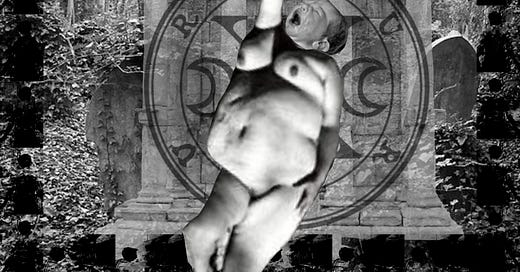




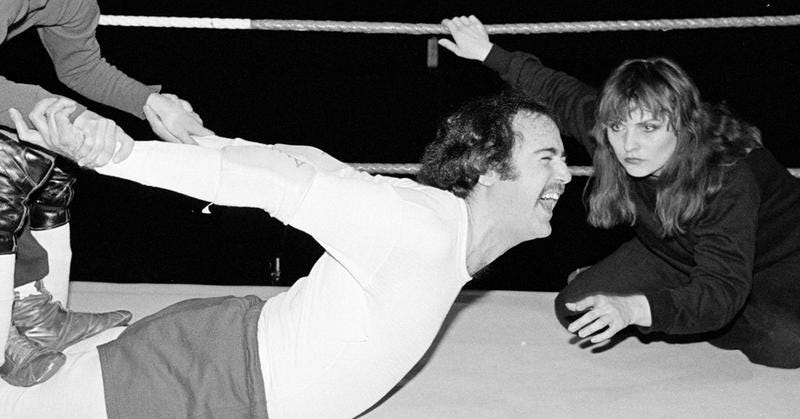



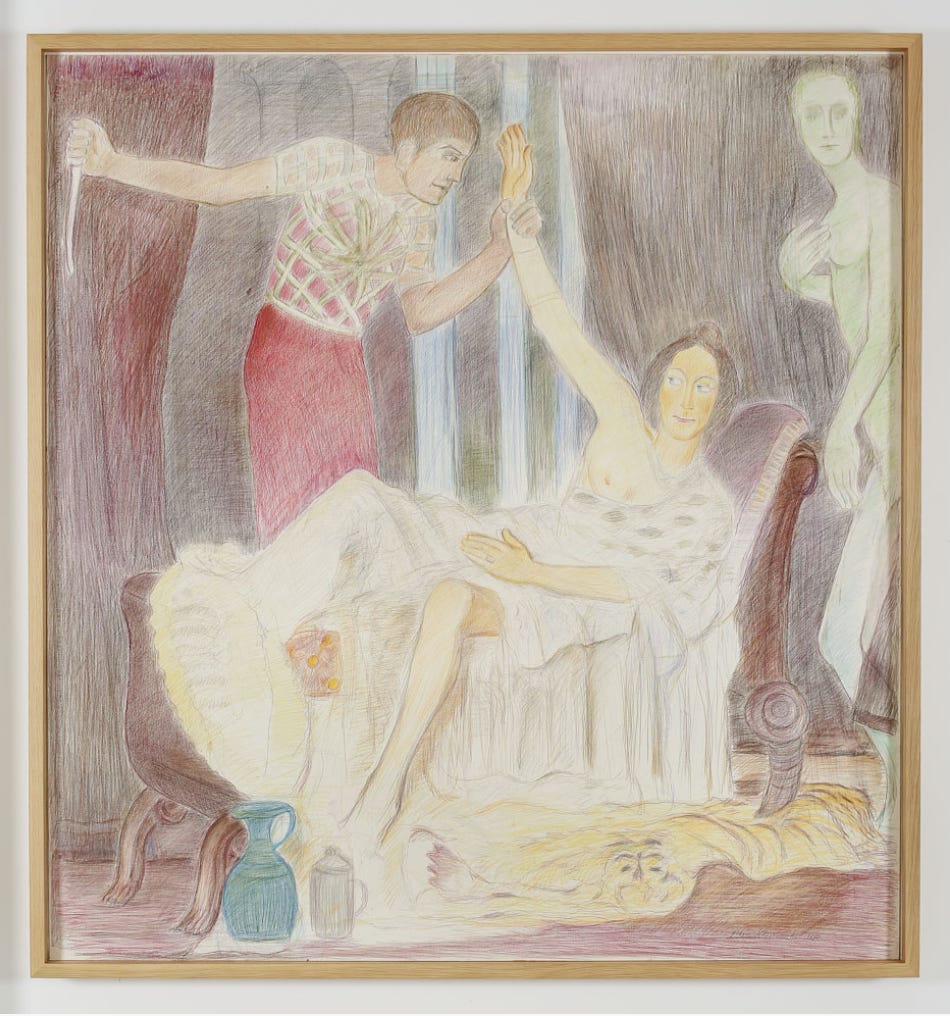

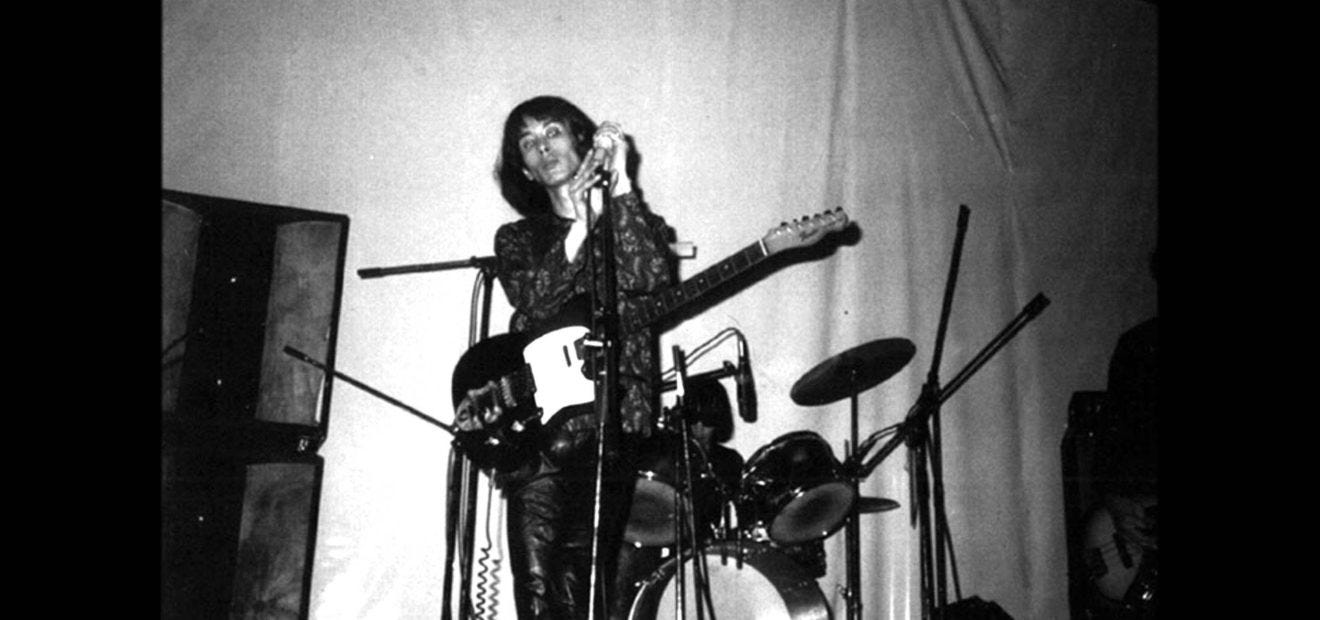
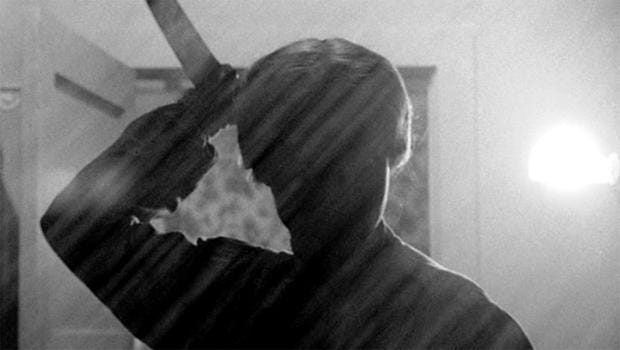
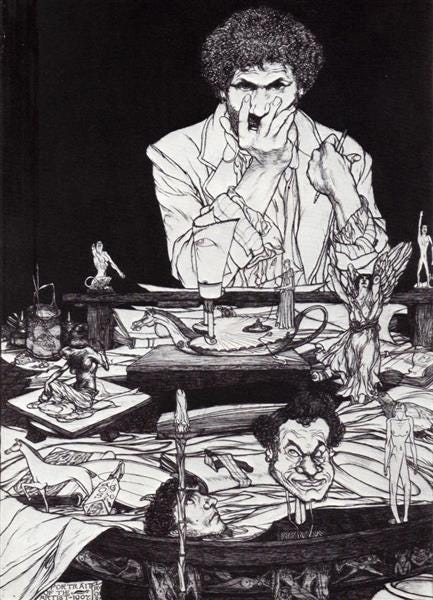
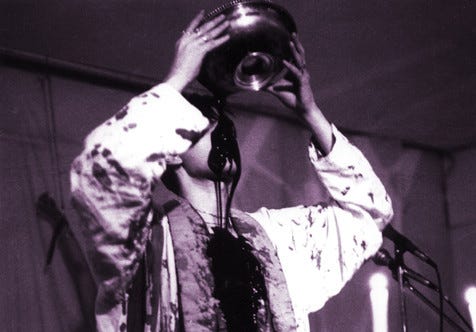

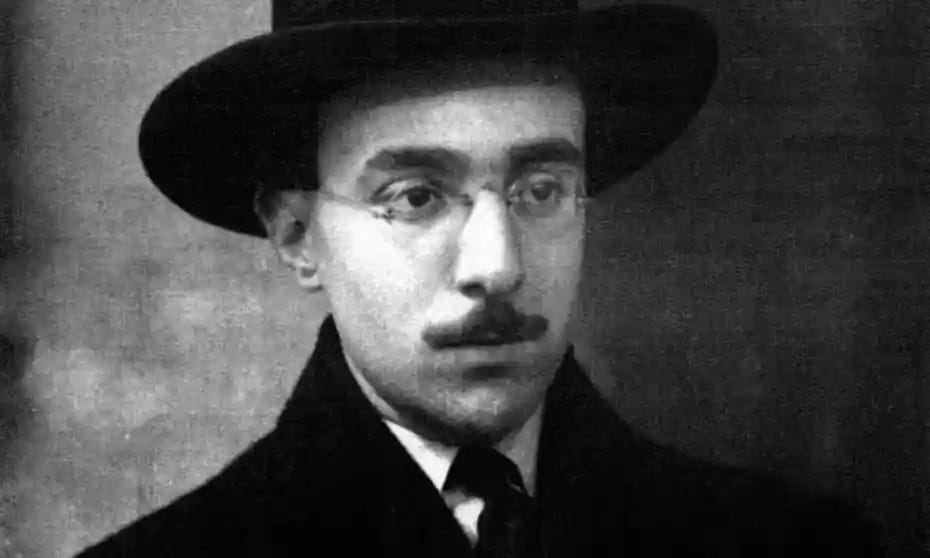
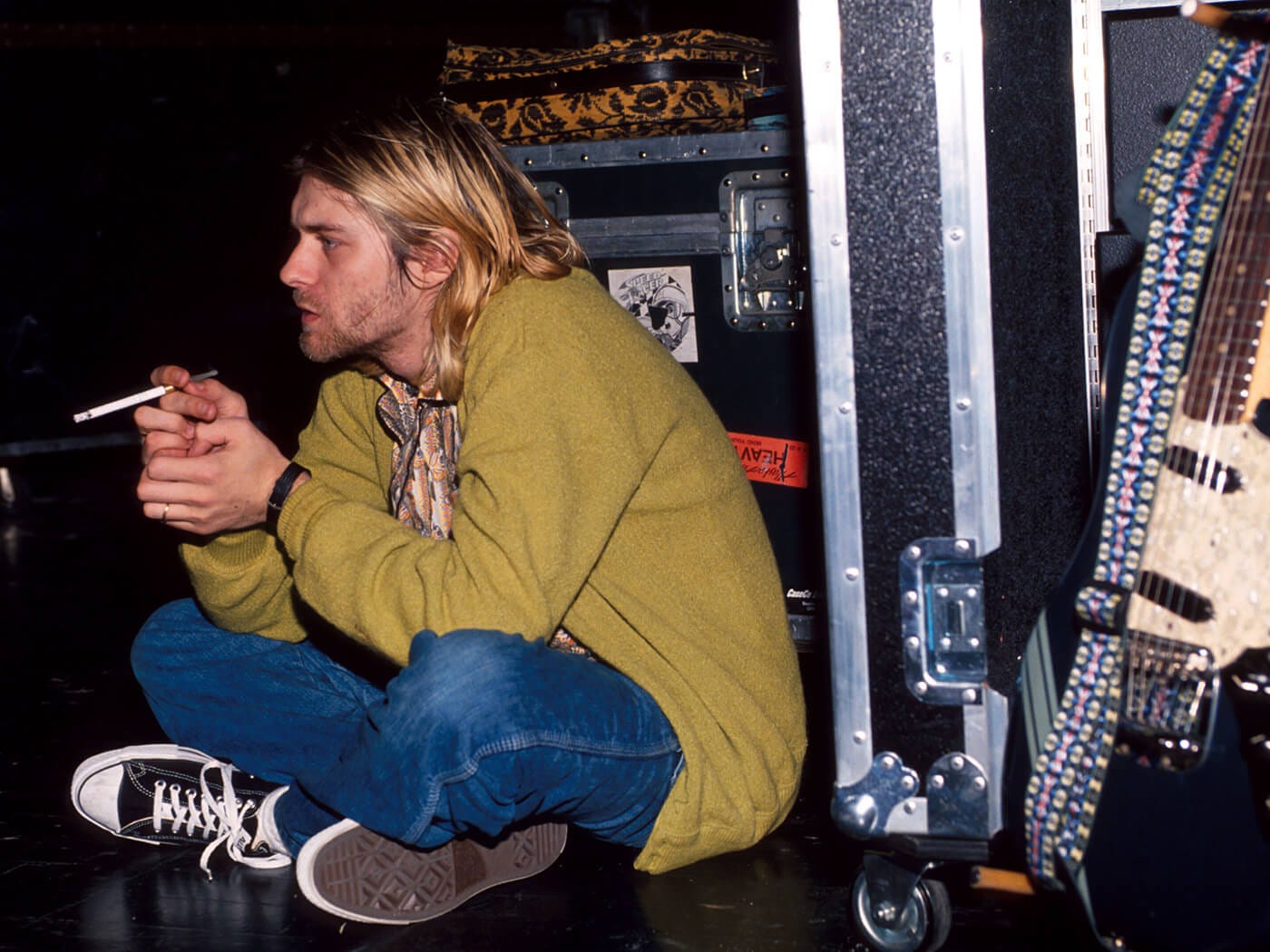

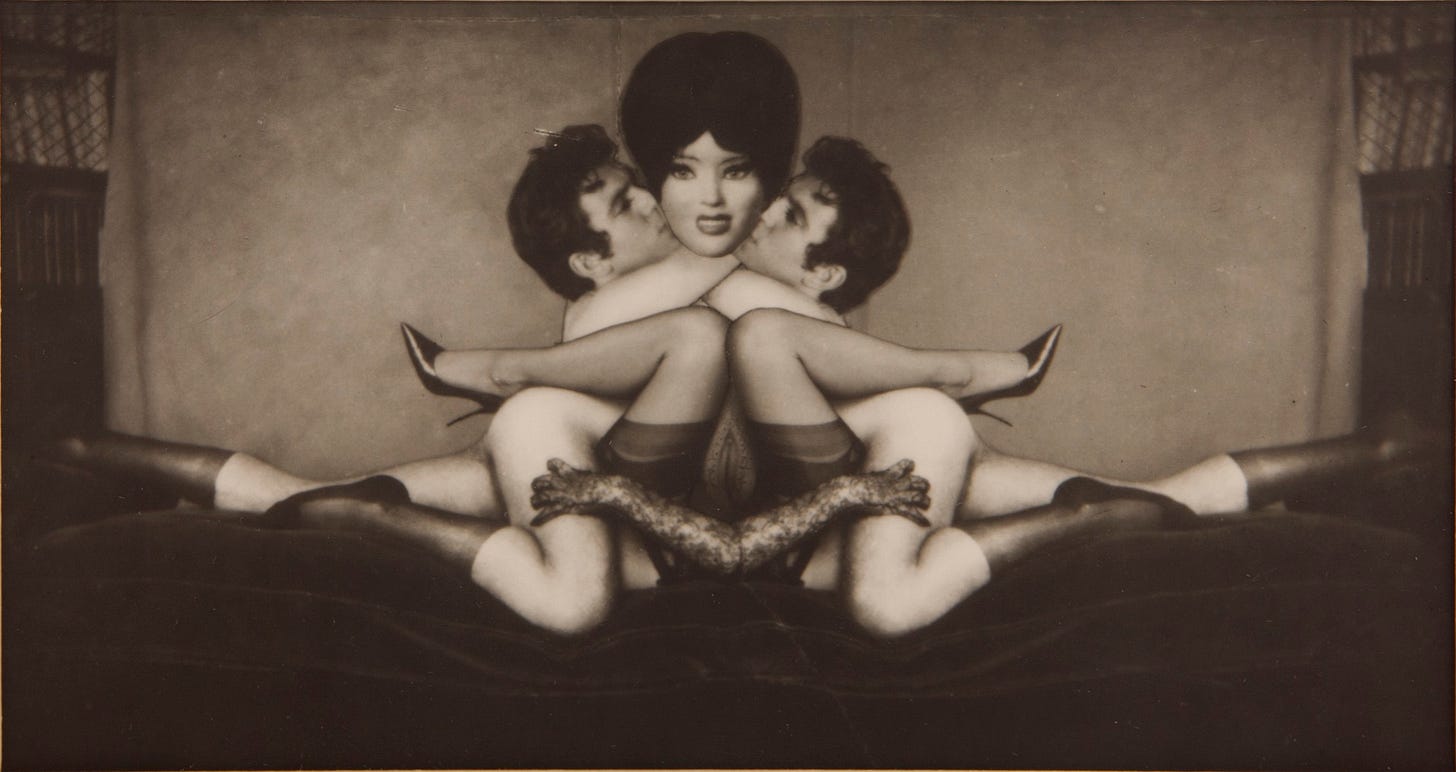

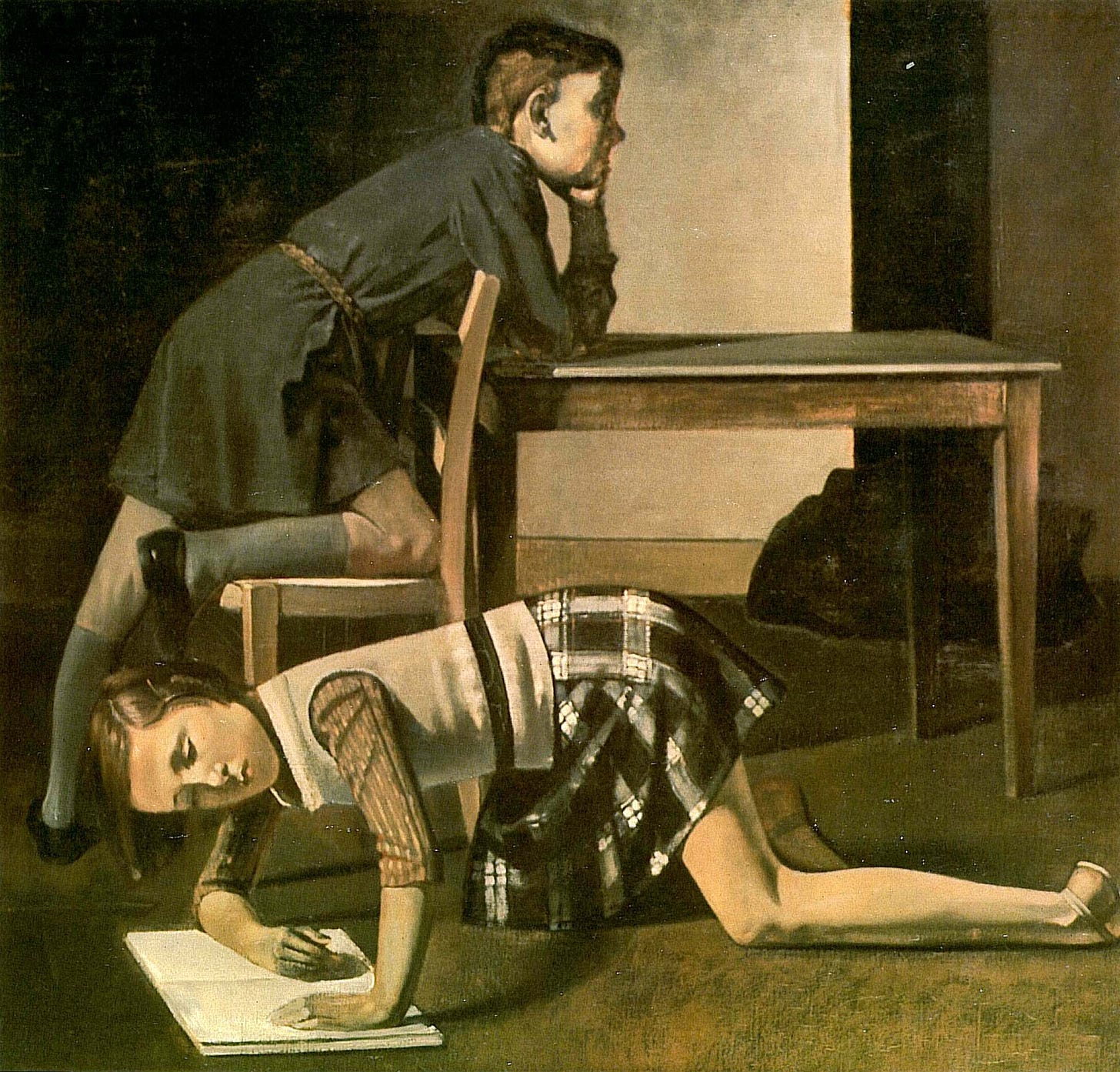


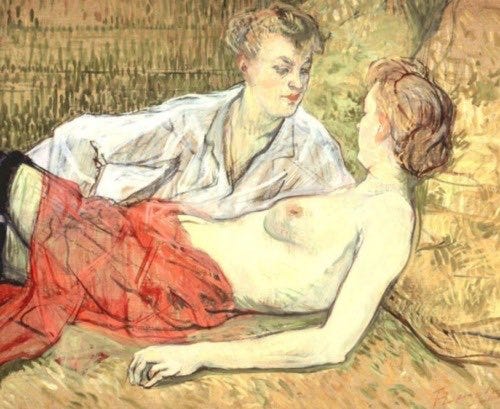
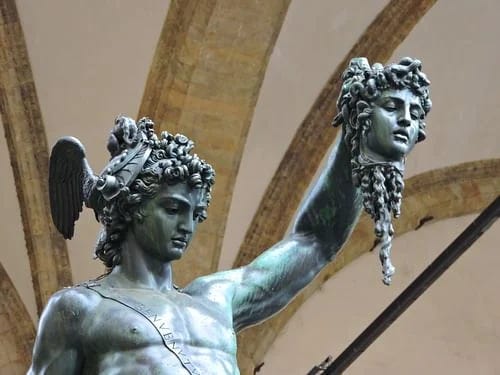
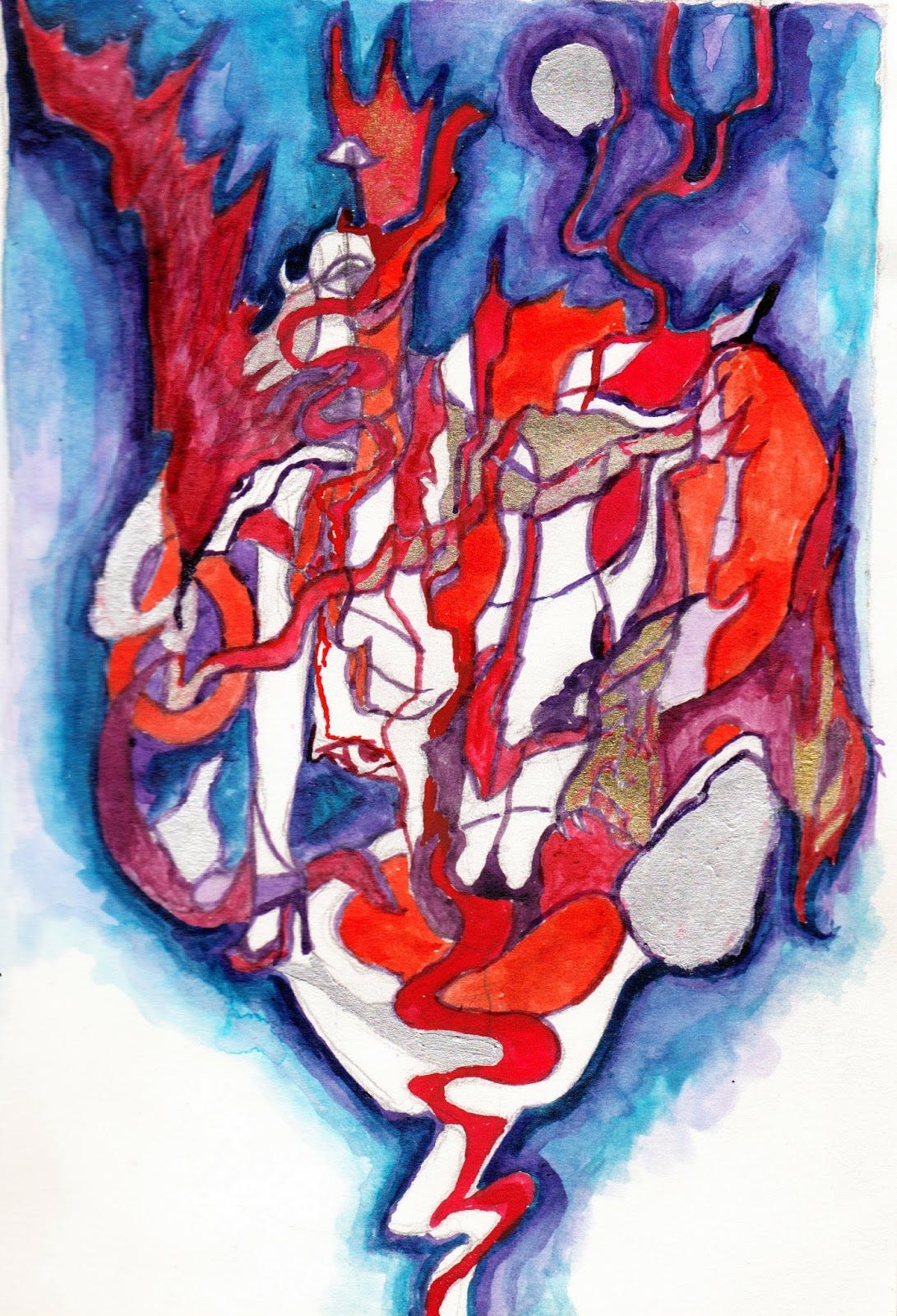

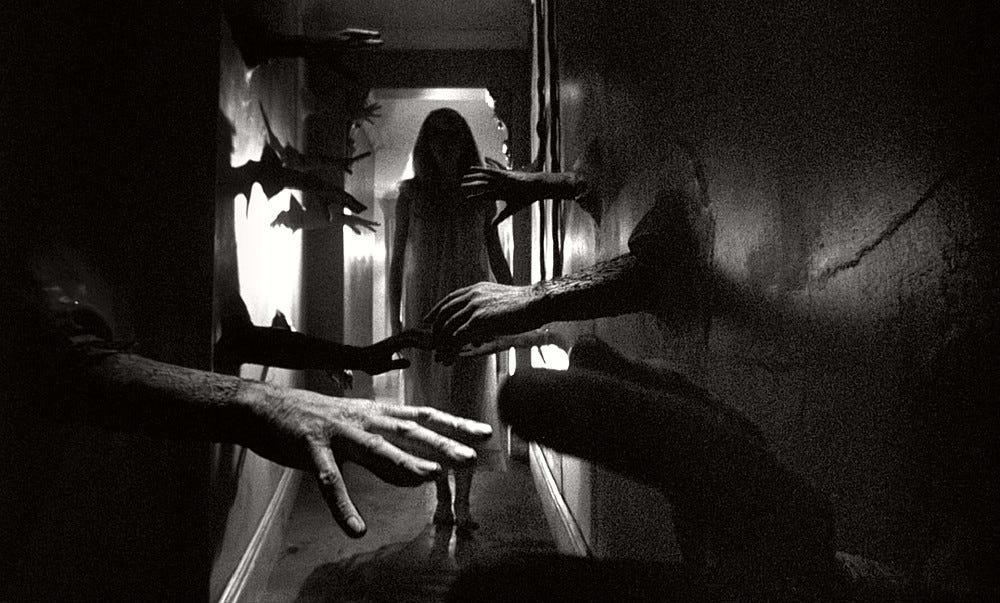


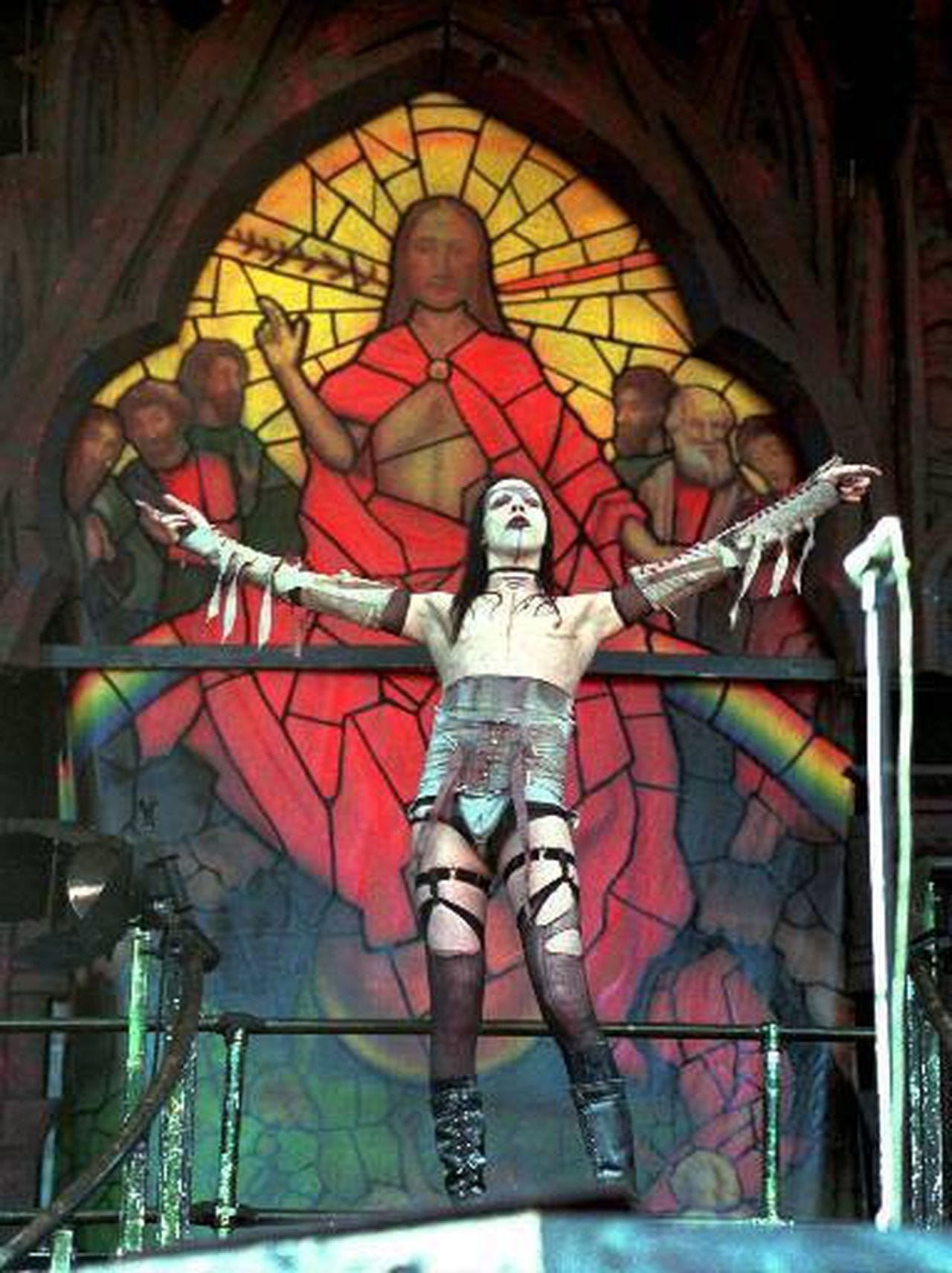
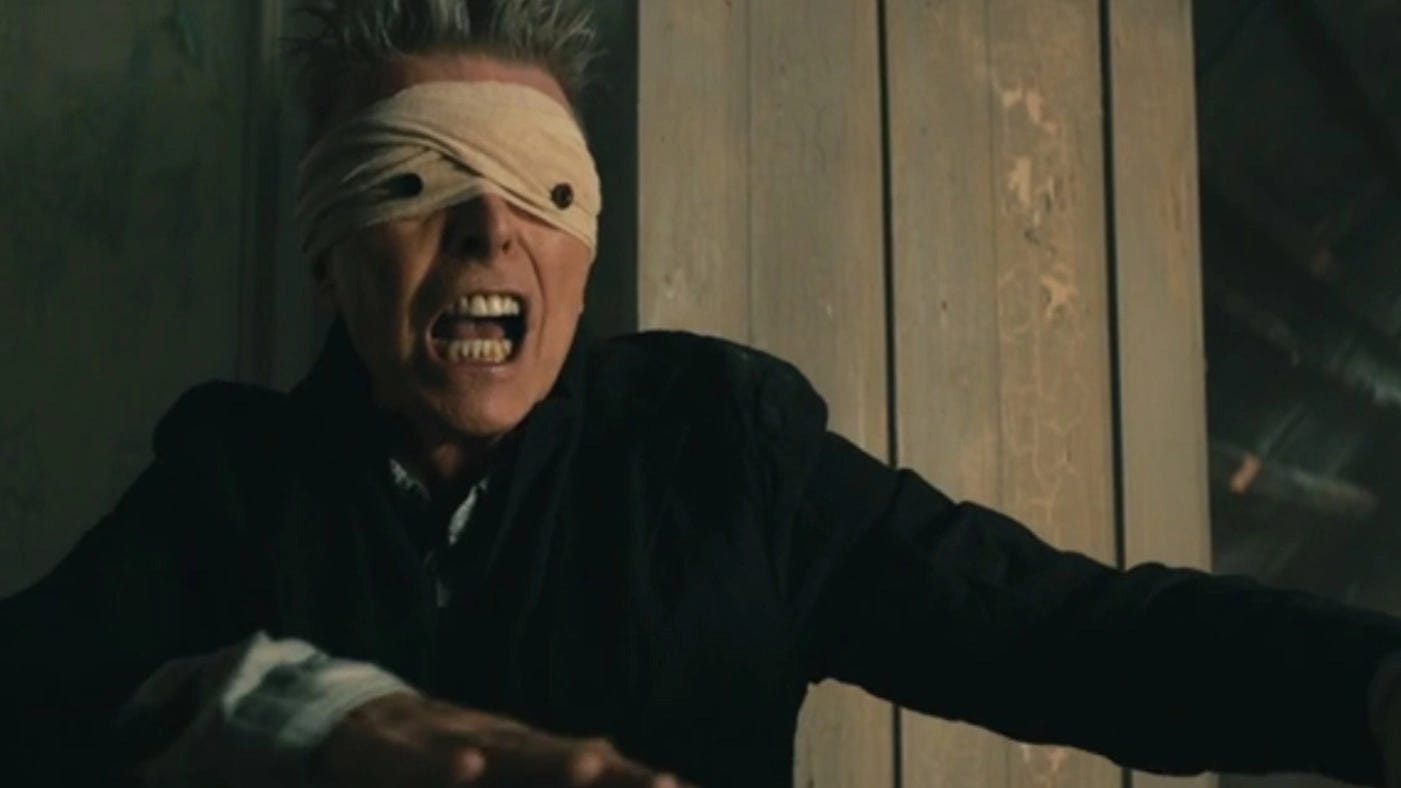
that was fucking great adam. thanks
Fantastic project. Learned a great deal. My one qualm is that I didn’t notice Francis Picabia. If you don’t know his history of ; debauchery, opium use, his financial sacrifices, check him out. Thanks!